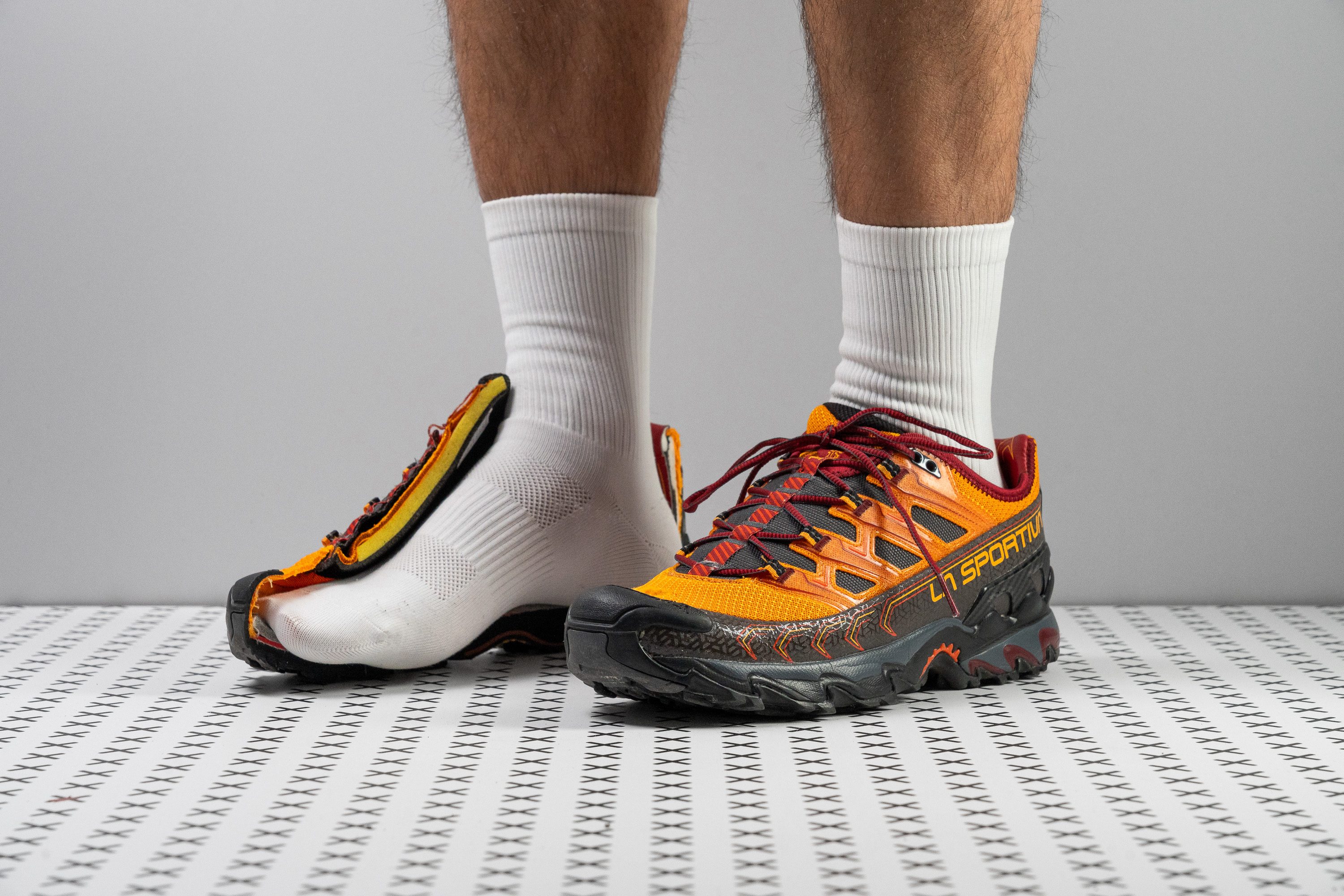Nuestra conclusión
Pros
- Muy buen agarre en terrenos técnicos
- Muy buena sujeción y estabilidad
- Protegen bien los pies
- Peso razonable
- Transpirabilidad decente
- El rebote en el antepié mejora la fluidez de la pisada
- Antepié flexible
Contras
- A la suela exterior le falta durabilidad (por el precio)
- Ajuste muy estrecho (pero disponible en tallas anchas)
- Bastante caras
Veredicto de los usuarios
- Top 12% entre zapatillas de senderismo
- Top 12% entre Zapatillas de senderismo para pies anchos
Comparativa
Las zapatillas de senderismo más parecidas
+ + Añadir unas zapatillas | |||||
|---|---|---|---|---|---|
| Puntuación global | 90 Excelentes | 69 Aceptables | 80 Buenas | 89 Notables | |
| Precio | 180 € | 170 € | 130 € | 130 € | |
| Terreno de trail | ModeradoTécnico | Moderado | Técnico | Técnico | |
| Peso laboratorio Peso marca | 12.7 oz / 359g 12.5 oz / 355g | 13.5 oz / 383g 12.8 oz / 363g | 13.9 oz / 393g 14 oz / 397g | 15.3 oz / 434g 16.2 oz / 460g | |
| Lightweight | ✓ | ✓ | ✓ | ✗ | |
| Transpirabilidad | Media | Media | Baja | Alta | |
| Uso | Senderismo de un día | Senderismo de un día | Senderismo de un díaPara principiantes | Senderismo de un díaPara principiantes | |
| Orthotic friendly | ✓ | ✓ | ✓ | ✓ | |
| Drop laboratorio | 10.6 mm | 10.2 mm | 14.1 mm | 11.2 mm | |
| Talla | Media talla más pequeñas | - | Tallan bien | Tallan bien | |
| Rigidez de la mediasuela | Equilibrada | Firme | Firme | Firme | |
| Diferencia de la rigidez de la mediasuela en frío | Estándar | Estándar | Pequeña | Estándar | |
| Rigidez torsional | Firmes | Firmes | Moderadas | Moderadas | |
| Rigidez del contrafuerte del talón | Flexibles | Moderadas | Moderadas | Flexibles | |
| Flexibilidad | Flexible | Moderada | Flexible | Flexible | |
| Dureza de la suela | Estándar | - | Muy dura | Estándar | |
| Material | Malla | - | MallaAnte | Piel o cueroMalla | |
| Estación | Cualquiera | Cualquiera | Invierno | VeranoCualquiera | |
| Durabilidad de la parte delantera | Mala | Buena | Muy buena | - | |
| Durabilidad del acolchado del talón | Media | Baja | Baja | - | |
| Durabilidad de la suela exterior | Decente | Decente | Decente | - | |
| Anchura / ajuste | Estrecha | Media | Media | Media | |
| Anchura de la parte delantera | Estrecha | Media | Media | Media | |
| Profundidad del dibujo de la suela | 4.4 mm | 4.5 mm | 4.3 mm | 4.8 mm | |
| Altura de la suela en la zona del talón laboratorio | 32.7 mm | 29.1 mm | 30.8 mm | 31.7 mm | |
| Antepié | 22.1 mm | 18.9 mm | 16.7 mm | 20.5 mm | |
| Anchuras disponibles | Estándar | Estándar | EstándarAncho | EstándarAncho | |
| Tecnología | Gore-TexOrtholite | Ortholite | - | Vibram | |
| Tirador del talón | Ninguno | Tirador circular | Tirador circular | Tirador circular | |
| Removable insole | ✓ | ✓ | ✓ | ✓ | |
| Clasificación | #4 Top 12% | #34 2% inferior | #29 17% inferior | #7 Top 20% | |
| Popularidad | #12 Top 35% | #22 37% inferior | #18 48% inferior | #1 Top 3% |
Quién debería comprárselas
Creemos que las Ultra Raptor II deberían estar en tu punto de mira si:
- Necesitas unas buenas zapatillas de montaña que ofrezcan un agarre inigualable.
- Sueles hacer senderismo cuando no llueve y hacer calor y en zonas por encima del nivel de los árboles.
- Quieres un modelo reforzado que ofrezca mucha protección contra las rocas.
- Prefieres las zapatillas de senderismo ceñidas.

Quién NO debería comprárselas
Si necesitas unas zapatillas de trail para rutas más sencillas en terrenos moderados, puedes ahorrarte una pasta probando con otros modelos de Merrell, como las Moab 3 o las Moab Speed 2.
Ambas ofrecen un ajuste más espacioso para pies de tamaño medio y anchos.
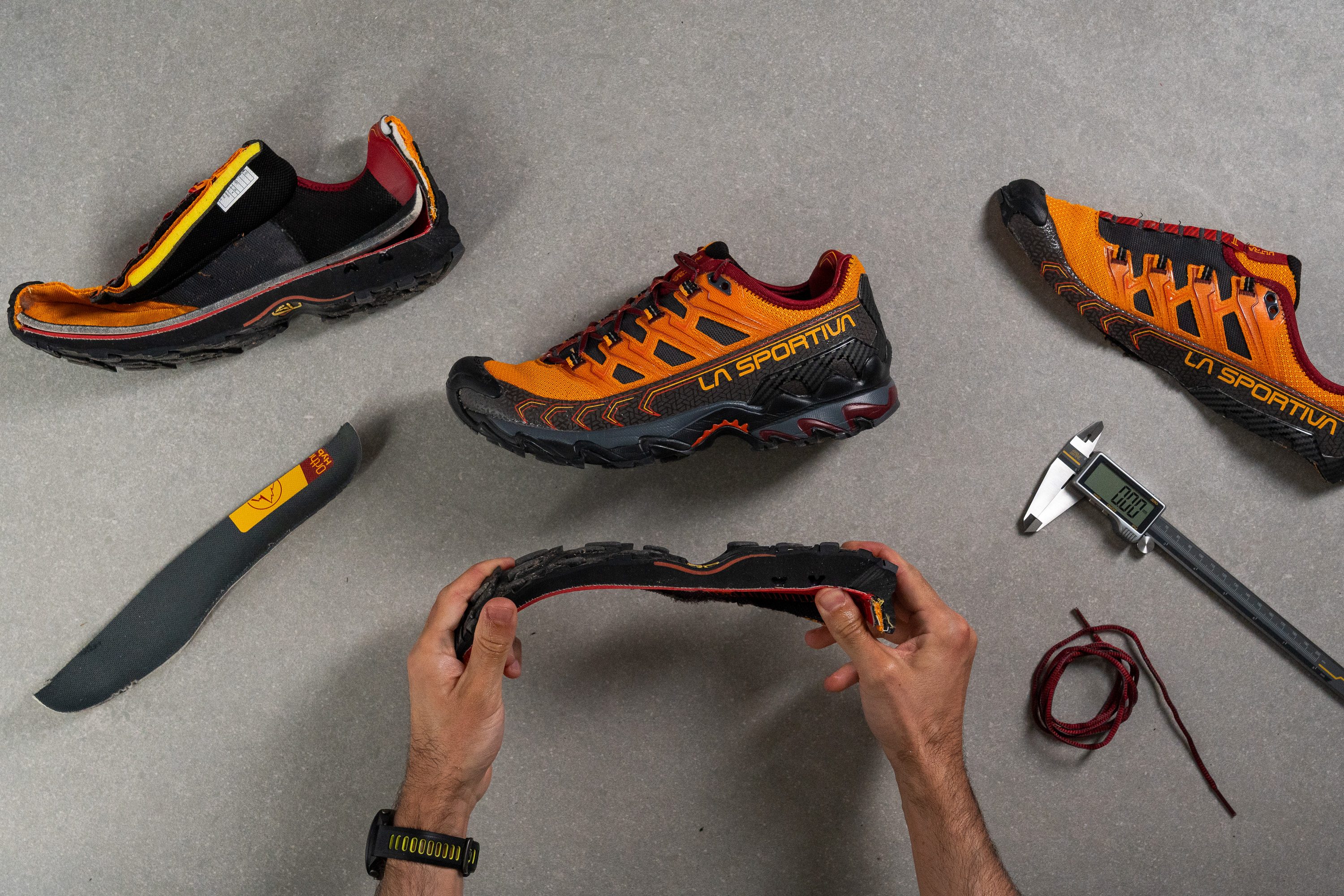
Amortiguación
Shock absorption
Las Ultra Raptor II tienen nivel de amortiguación muy alto para ser unas zapatillas diseñadas para los terrenos técnicos y complejos.
Con un resultado sólido de 105 SA, protegen el pie de los encuentros dolorosos con rocas y otros obstáculos afilados, mientras se reduce el estrés en las articulaciones en los terrenos uniformes. Son un ejemplo perfecto de unas zapatillas que ofrecen una buena protección bajo los pies sin hacer que pierdas contacto con el suelo y sin afectar negativamente a la colocación precisa del pie.
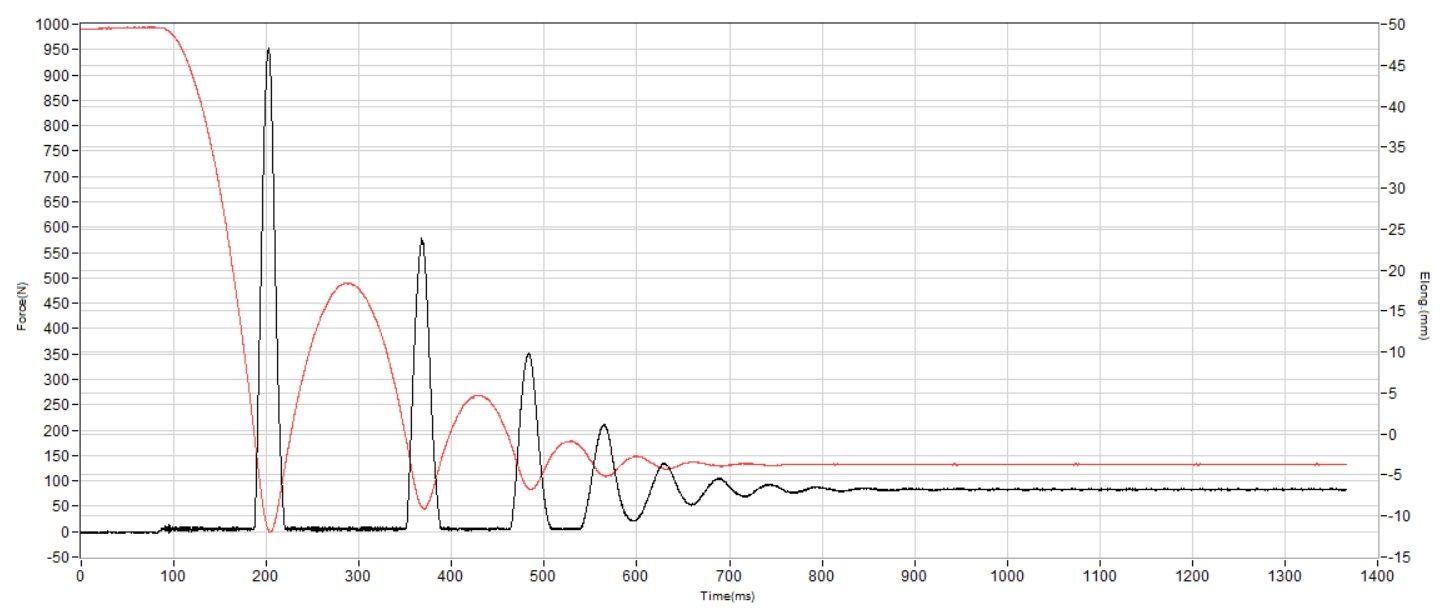
| Ultra Raptor II | 105 SA |
| Media | 104 SA |
Energy return
De todos modos, lo mejor es que tengas en cuenta que estas zapatillas no tienen mucho rebote, ya que priorizan que la pisada sea estable y firme. Por eso su retorno de energía es tan bajo: solo del 45 %.
| Ultra Raptor II | 44.7% |
| Media | 50.2% |
Altura de la suela en la zona del talón
Según nuestra propia experiencia, la mediasuela de las Ultra Raptor II ofrece un buen equilibrio entre el contacto con el suelo y la protección contra impactos. Así que, cuando cortamos las zapatillas por la mitad en nuestro laboratorio, sus medidas reflejaron justo eso.
La suela del talón tiene una altura estándar de 32,7 mm, lo que nos parece suficiente para una ruta alpina con mucha roca de por medio. Al fin y al cabo, es mejor que no estés separadísimo del suelo, ya que es más difícil corregir un paso en falso en una plataforma más alta.
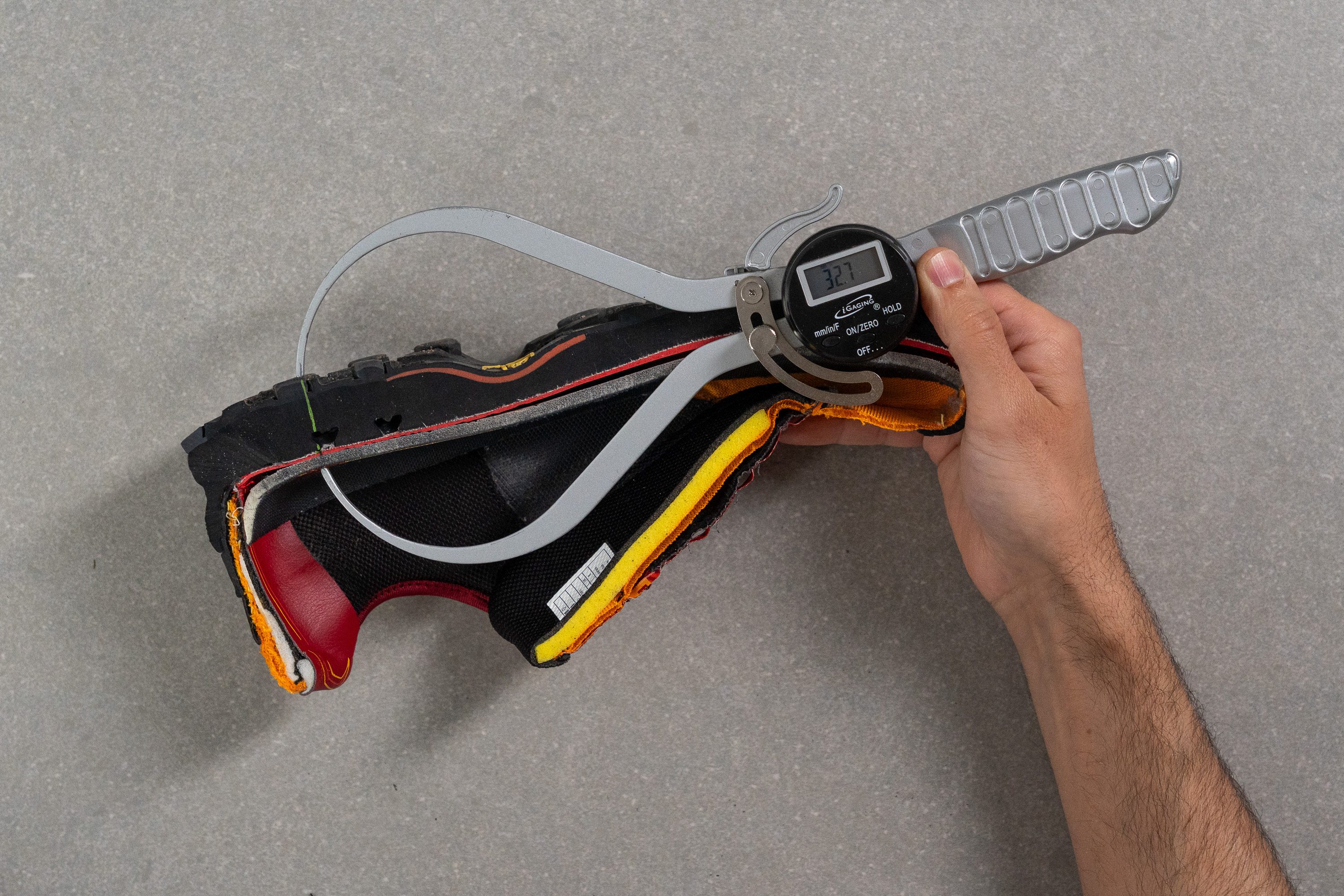
| Ultra Raptor II | 32.7 mm |
| Media | 32.8 mm |
Altura de la suela en el antepié
Una moderada suela en el antepié de 22,1 mm también ayuda a que las zapatillas tengan un mejor contacto con el suelo. Lo bueno es que, al mismo tiempo, ofrecen suficiente protección contra impactos y protegen tanto los metatarsos como las articulaciones de los dedos.

| Ultra Raptor II | 22.1 mm |
| Media | 22.0 mm |
Drop
Al comprobar la diferencia entre las alturas de la suela, vimos que estas zapatillas tienen un drop de 10,6 mm.
En este diseño, el talón está un poco más arriba del nivel de los dedos, aliviando la tensión del pie y del tendón de Aquiles. Está a la altura de la media de la categoría, por lo que la mayoría de los excursionistas deberían disfrutar de una experiencia conocida.
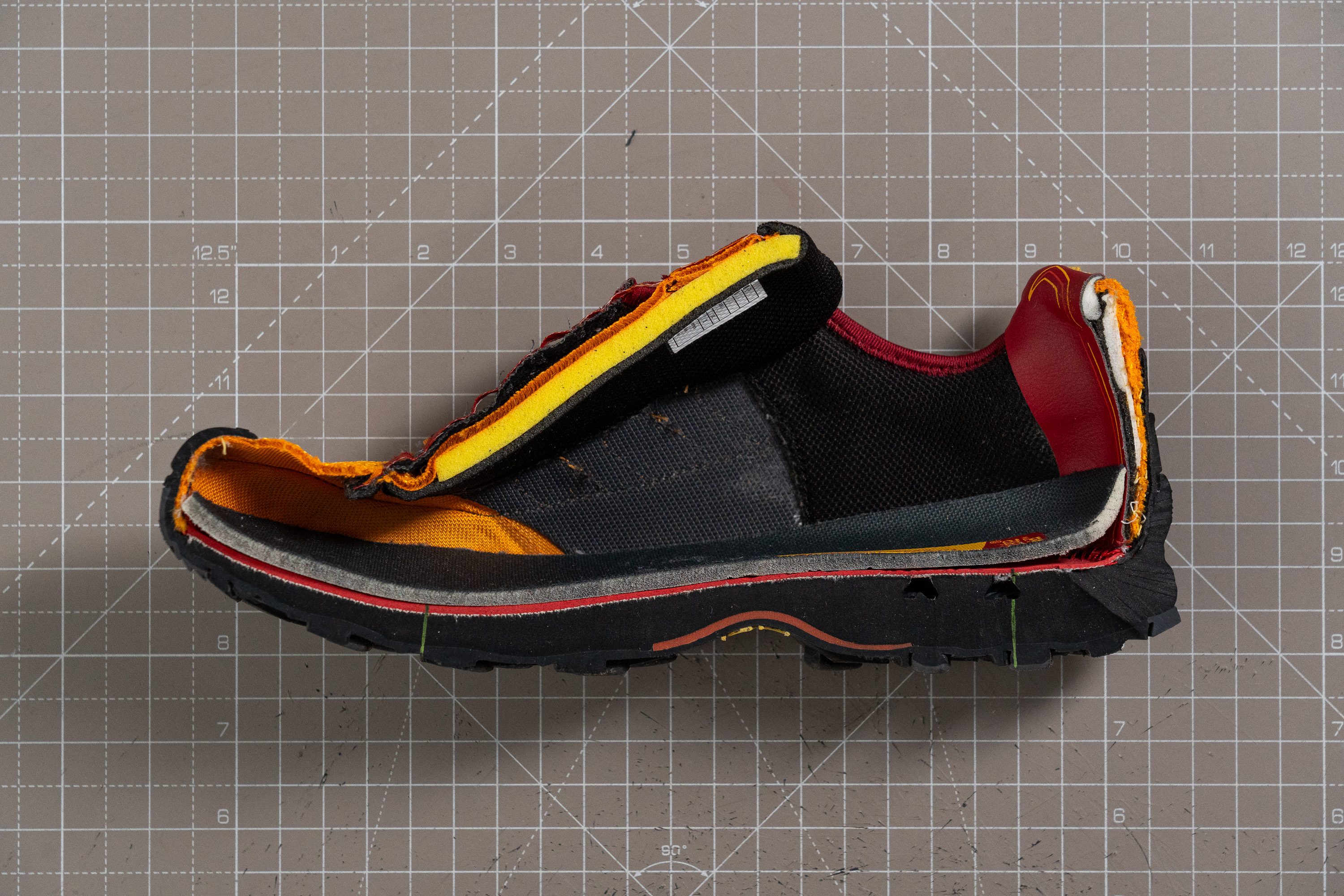
| Ultra Raptor II | 10.6 mm |
| Media | 10.7 mm |
Suavidad de la mediasuela
Como La Sportiva comercializa las Ultra Raptor II como unas zapatillas de senderismo y trail running, tienen una espuma inflada de EVA para la amortiguación de la mediasuela. Este compuesto se describe como más reactivo que la espuma EVA comprimida de la marca (utilizada en sus zapatillas orientadas al senderismo y el trekking).
Sin embargo, las Raptor no nos parecieron unas zapatillas de trail running divertidas y con rebote, y mucho menos en comparación con nuestras números 1 en esta categoría.
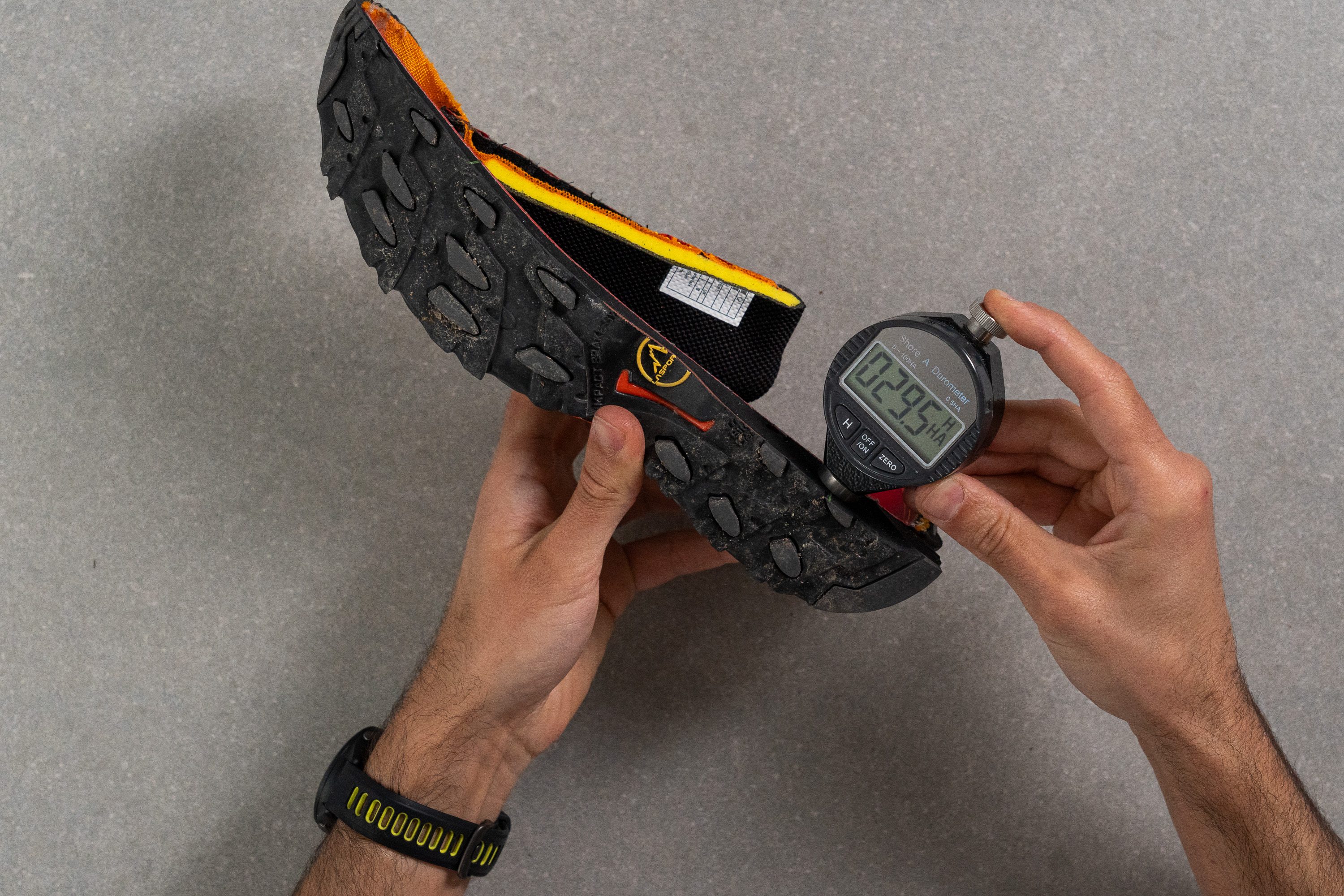
Cuando presionamos nuestro durómetro Shore A contra su espuma EVA, marcó un resultado alto de 29,5 HA, lo que no hizo más que confirmar su dureza. El resultado medio de las zapatillas de trail running (a día de hoy) en esta prueba ronda los 22,0 HA (son un 35 % más blandas que las Raptor).
| Ultra Raptor II | 29.5 HA |
| Media | 27.0 HA |
Rocker
Como se supone que estas zapatillas de La Sportiva también sirven para el trail running, tienen un rocker pronunciado en la parte delantera.
Este diseño nos pareció ideal para hacer senderismo, ya que suaviza los despegues y ayuda a reducir el esfuerzo muscular en las pendientes pronunciadas.
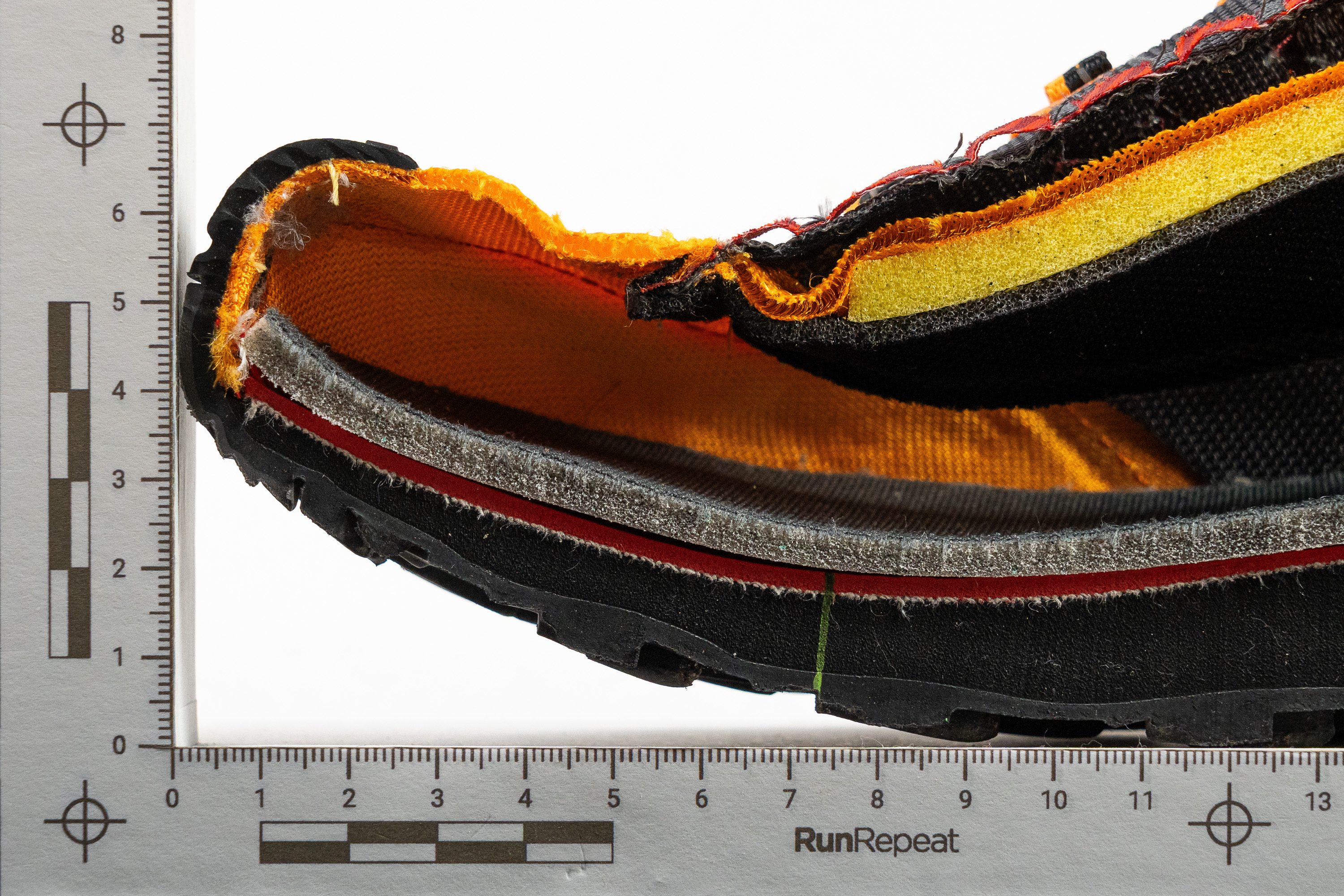
Tallaje y ajuste
Talla
Las La Sportiva Ultra Raptor II son media talla más pequeñas (15 votos).
Plantéate subir media talla
Anchura / Ajuste
Aunque parecen grandotas, las La Sportiva Ultra Raptor II son unas zapatillas muy ajustadas y ceñidas, y nuestro molde de gel finito lo refleja a la perfección.
Cuando medimos el punto más ancho del molde de gel con un calibre, vimos que solo alcanzaba 90,1 mm en su punto más ancho. Por lo tanto, es bastante más estrecho que la media, ¡incluso para los pies de anchura media!
Lo bueno es que te puedes comprar estas zapatillas en versión ancha. Se supone que esto añade 10 mm de circunferencia en la parte delantera y 5 mm de altura en esa misma zona.
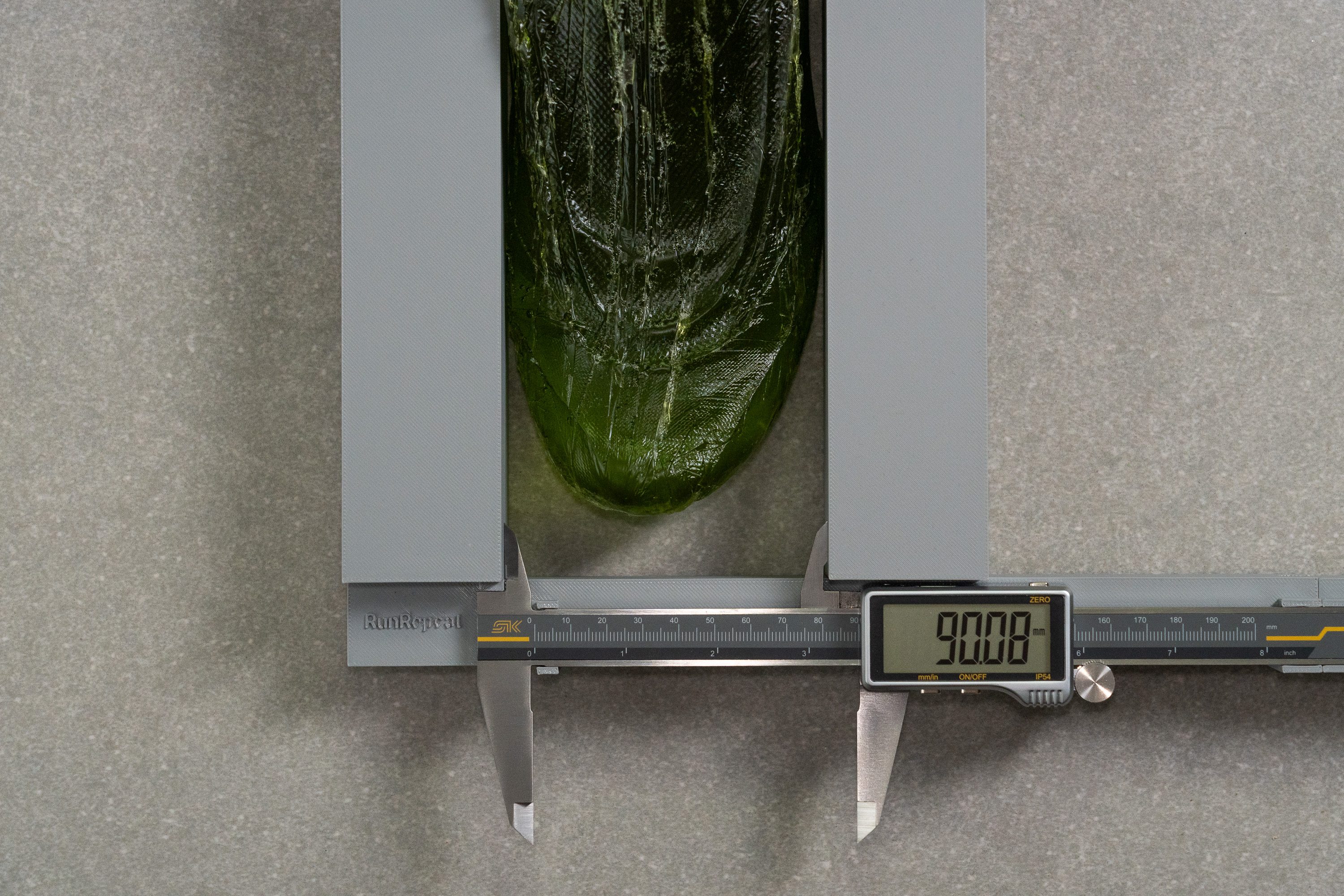
| Ultra Raptor II | 90.1 mm |
| Media | 94.1 mm |
Anchura de la parte delantera
Como era de esperar, la parte delantera de estas zapatillas tampoco es muy ancha. Cuando medimos su anchura en la zona del dedo gordo, nuestro calibre marcó un resultado por debajo de la media: 68,8 mm.
Por lo tanto, las Ultra Raptor II no solo son estrechas en general, sino que su parte delantera también lo es. Esto hace que sean unas de las zapatillas de senderismo menos anchas que hemos visto en nuestro laboratorio.
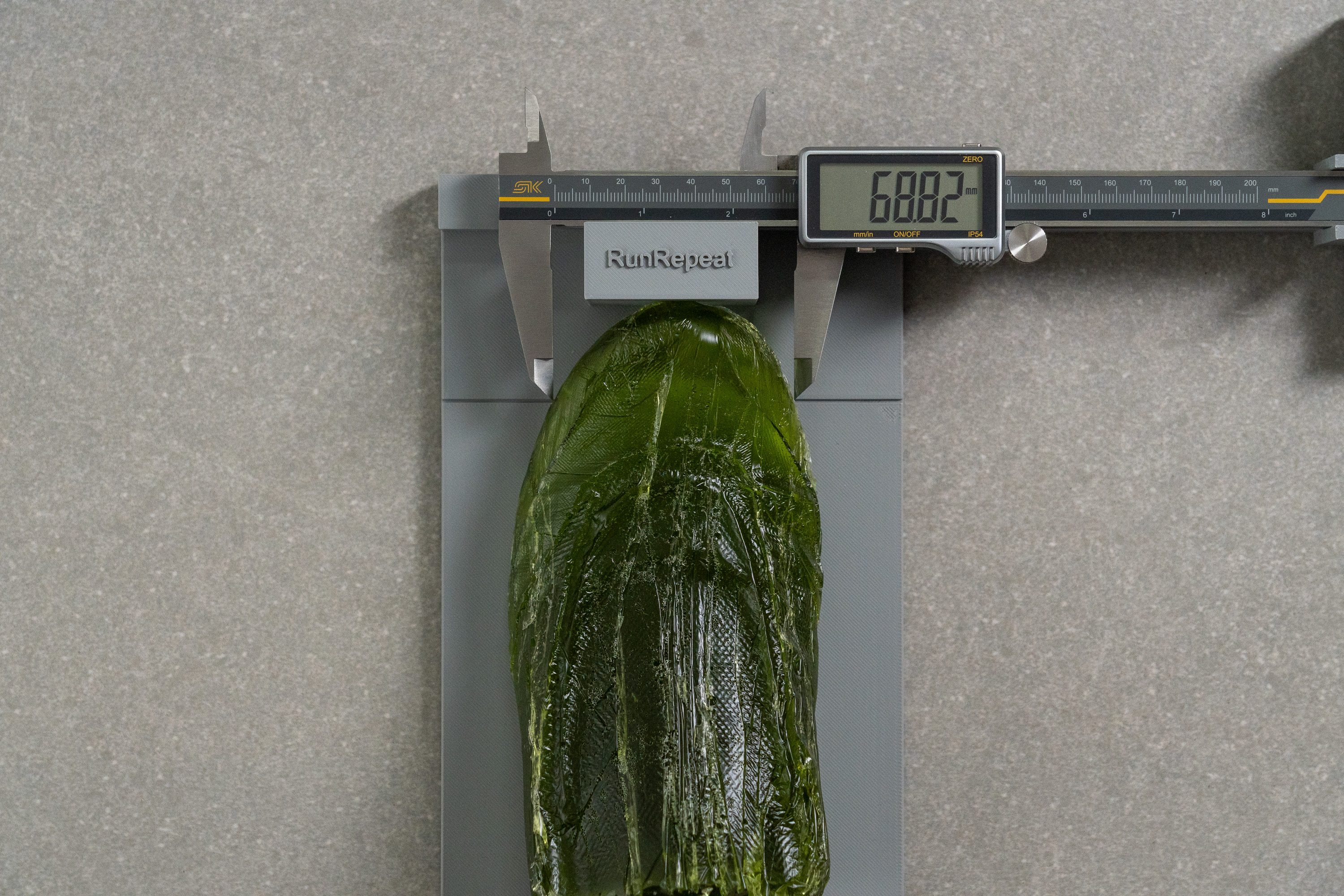
| Ultra Raptor II | 68.8 mm |
| Media | 72.5 mm |
Altura de la parte delantera
La altura de la parte delantera también es inferior a la media, con 25,3 mm.

No diríamos que su espacio vertical es demasiado escaso, pero la protección densa de la punta sí que lo limita.
| Ultra Raptor II | 25.3 mm |
| Media | 28.0 mm |
Tracción / Agarre
Profundidad del dibujo de la suela
Mientras su suela exterior permanezca intacta, las Ultra Raptor II te ofrecerán uno de los mejores agarres que te puedes esperar de unas zapatillas de senderismo.
Aunque la profundidad de sus tacos se llevó un resultado estándar en nuestro calibre (4,4 mm), este modelo se siente mucho más dentado de lo que indica la cifra anterior por todo el agarre que ofrece su caucho.
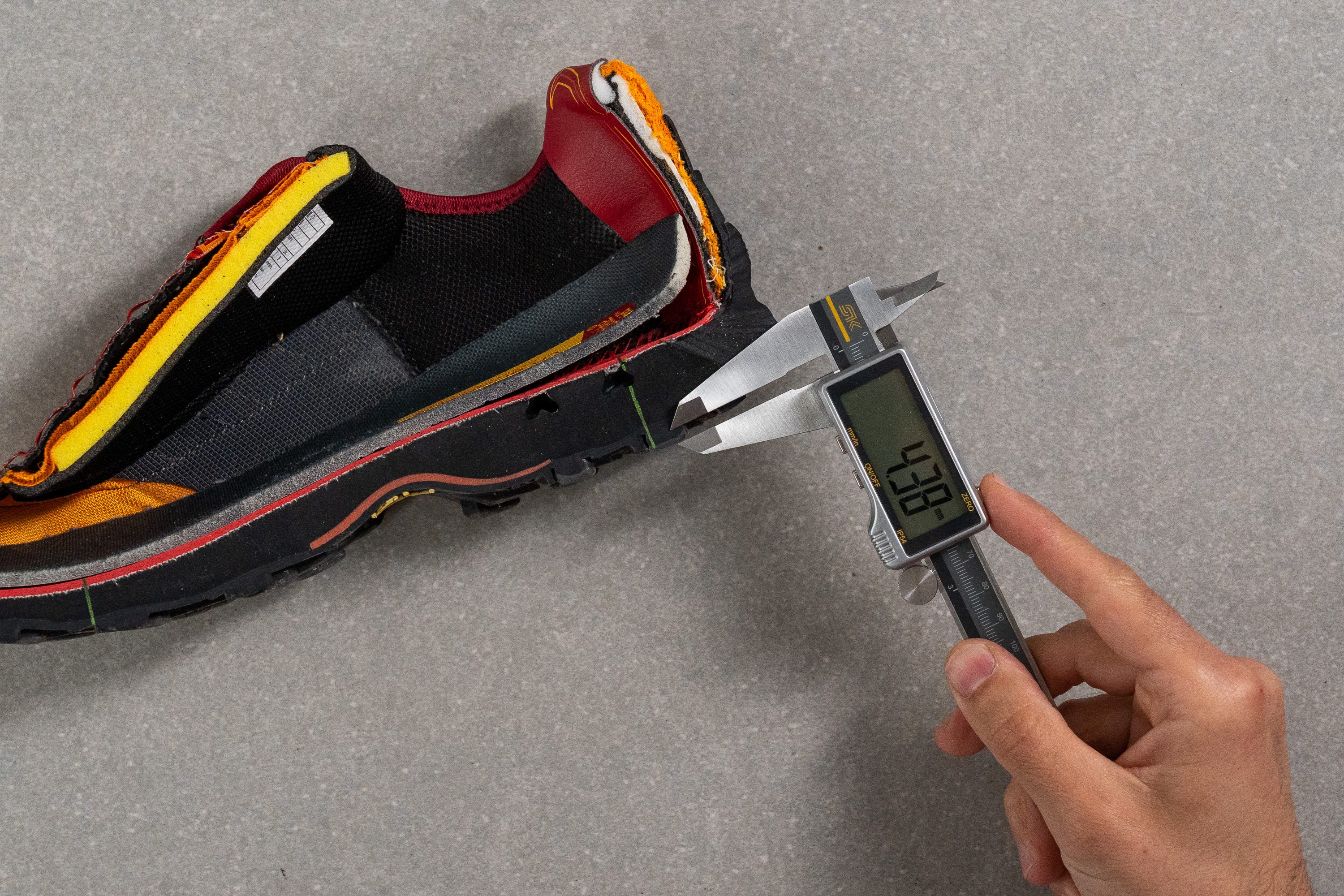
Este modelo de La Sportiva inspira mucha confianza tanto en superficies secas como mojadas, incluyendo rocas, troncos llenos de musgo y descensos cubiertos de hierba. Sin embargo, no es la mejor opción para enfrentarse al barro que no está denso, ya que para eso necesitarías unos tacos más profundos (de 5-6 mm).
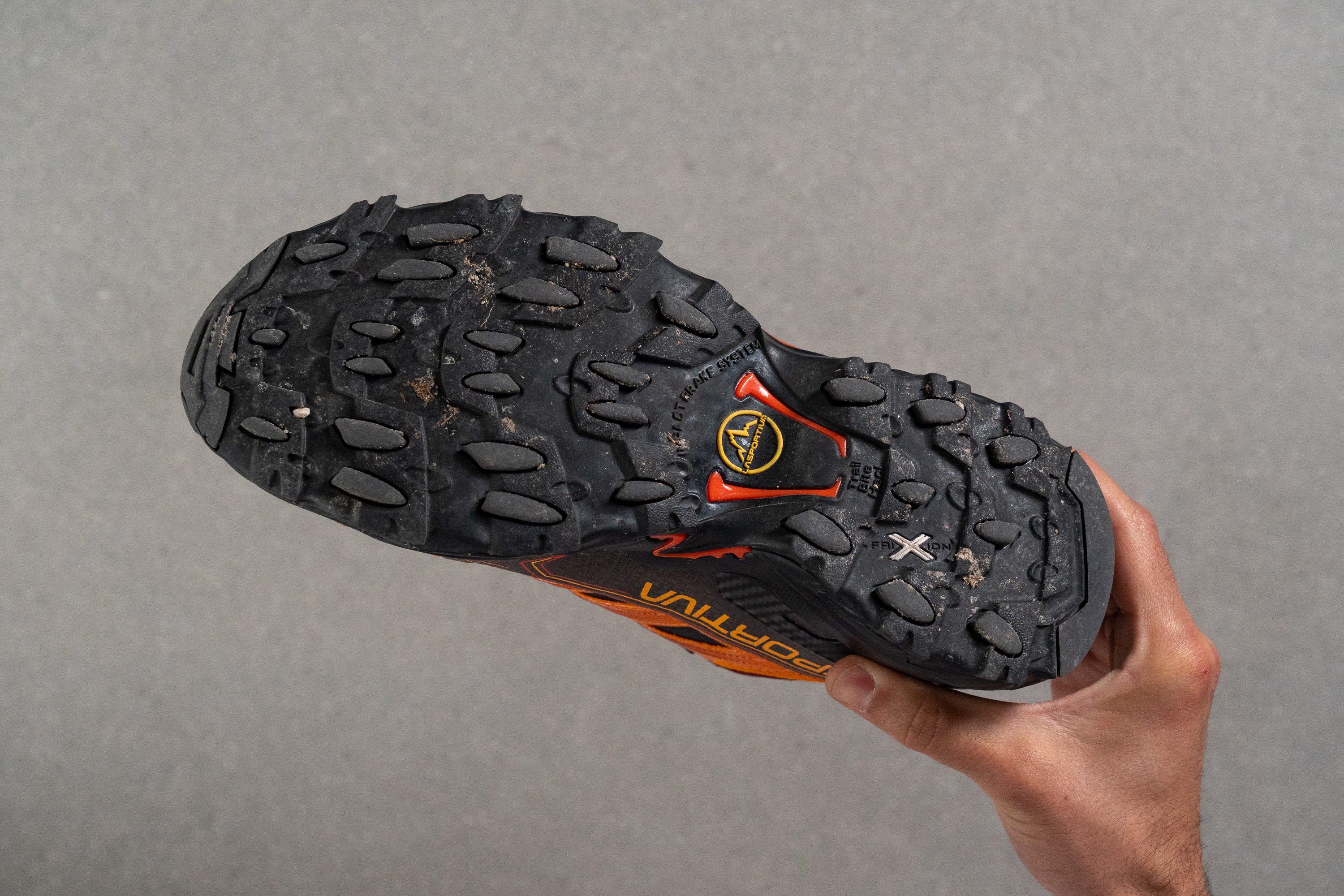
| Ultra Raptor II | 4.4 mm |
| Media | 4.0 mm |
Flexibilidad / Rigidez
El antepié flexible de las Raptor II fue una agradable sorpresa teniendo en cuenta lo rígida y lo llena de capas que está su estructura.
Con solo 11,2 N de fuerza para doblarse 30 grados, estas zapatillas de La Sportiva son incluso más flexibles que la media de las zapatillas de senderismo. Para ser exactos, son un 60 % más flexibles.
De hecho, esta es una de las características que hace que las Raptor se sientan un poco más como unas zapatillas de running. También disfrutamos de esa flexibilidad extra en el antepié para avanzar por las zonas llenas de piedras y subir pendientes pronunciadas.

| Ultra Raptor II | 11.2N |
| Media | 18.3N |
Peso
Las Ultra Raptor II están justo en la media de las zapatillas de senderismo no impermeables con sus 359 g. Como no tienen membrana Gore-Tex, son 14 g más ligeras que las Ultra Raptor II GTX.
Aunque siempre hay opciones más ligeras para el senderismo de un día, no sentimos que las Raptor fueran una carga para nuestros pies al final del día.
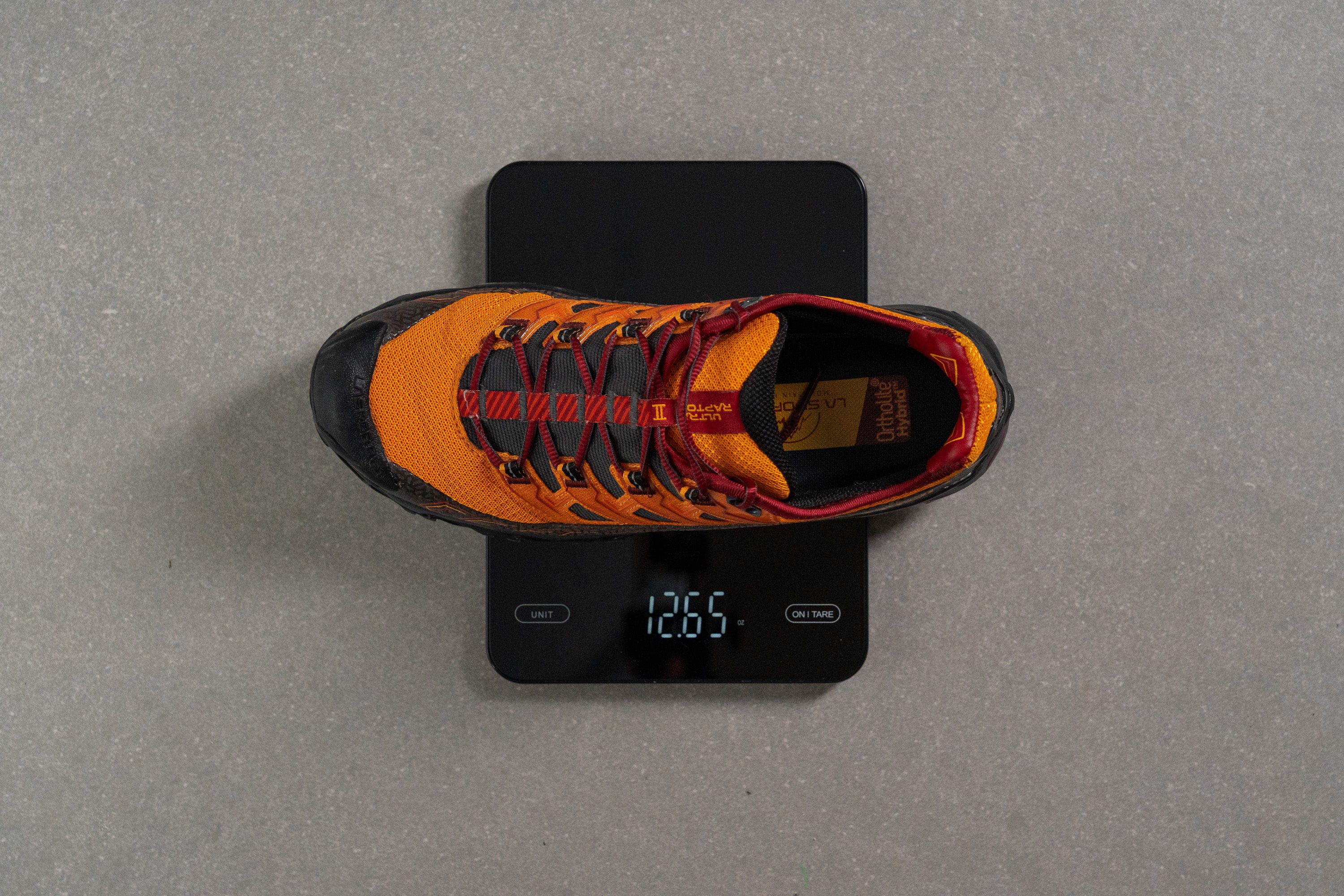
| Ultra Raptor II | 12.7 oz (359g) |
| Media | 13.4 oz (380g) |
Transpirabilidad
Las Ultra Raptor II son una versión más veraniega de esta serie de zapatillas de La Sportiva y utilizan una malla bastante fina y transparente para poder ofrecer una buena transpirabilidad.
Nuestra prueba de humo reveló que el material tiene un buen flujo de aire para cuando hace calor, pero tampoco es nada del otro mundo. Vamos, que las Raptor se llevaron una puntuación moderada en transpirabilidad: un 3/5.
Si haces senderismo cuando hace calor y necesitas que tus pies puedan respirar libremente, échale un ojo a nuestro catálogo de zapatillas de senderismo transpirables.
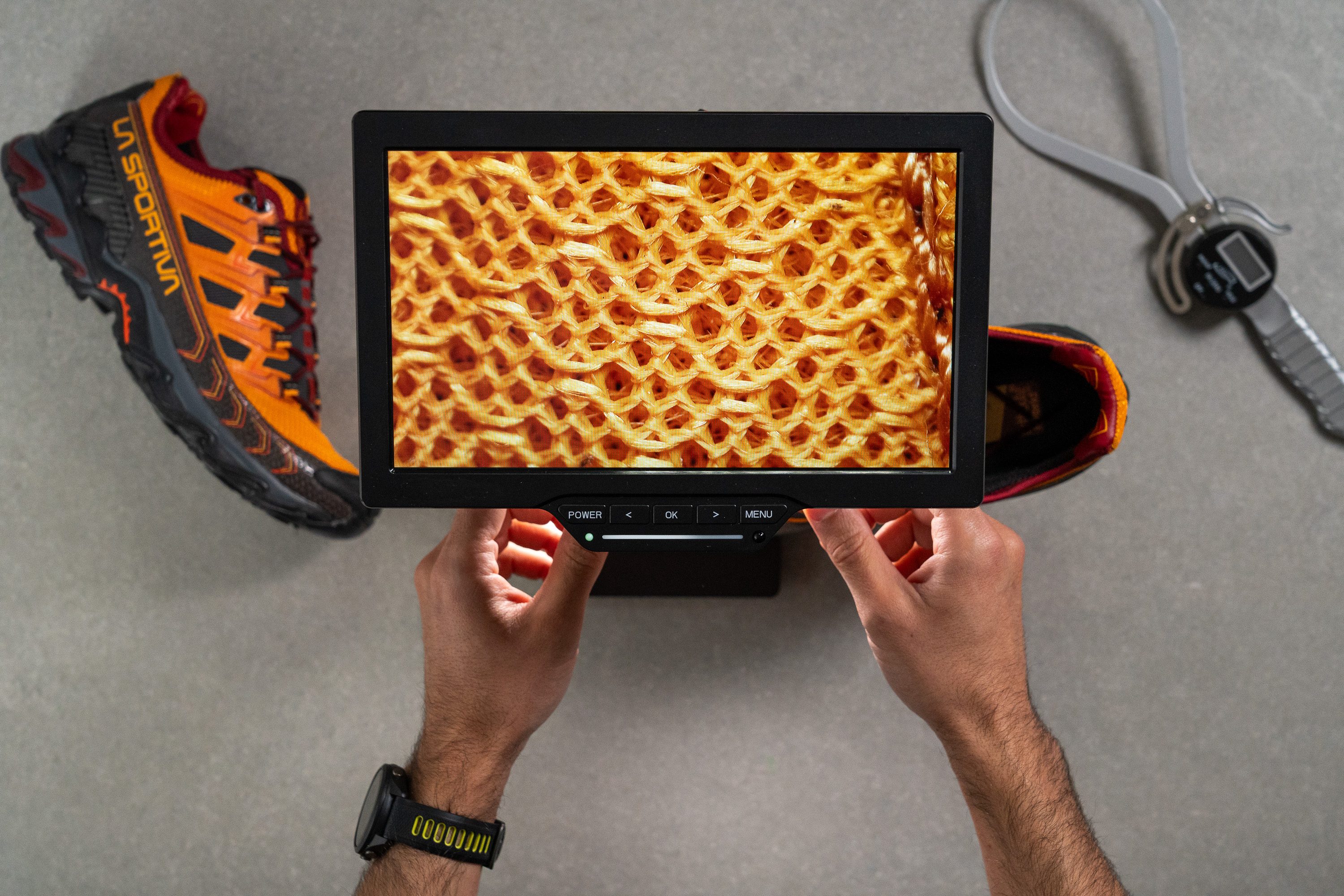
| Ultra Raptor II | 3 |
| Media | 2.4 |
Estabilidad
Prueba de estabilidad lateral
La estabilidad es el punto fuerte de las Ultra Raptor II.
Nos sentimos muy seguros con ellas en terrenos técnicos, llenos de rocas, irregulares y a menudo impredecibles.
Gracias a todos los elementos de sujeción que tienen y a los refuerzos de TPU, nuestros pies ni bailaron dentro de las zapatillas ni perdieron el control.
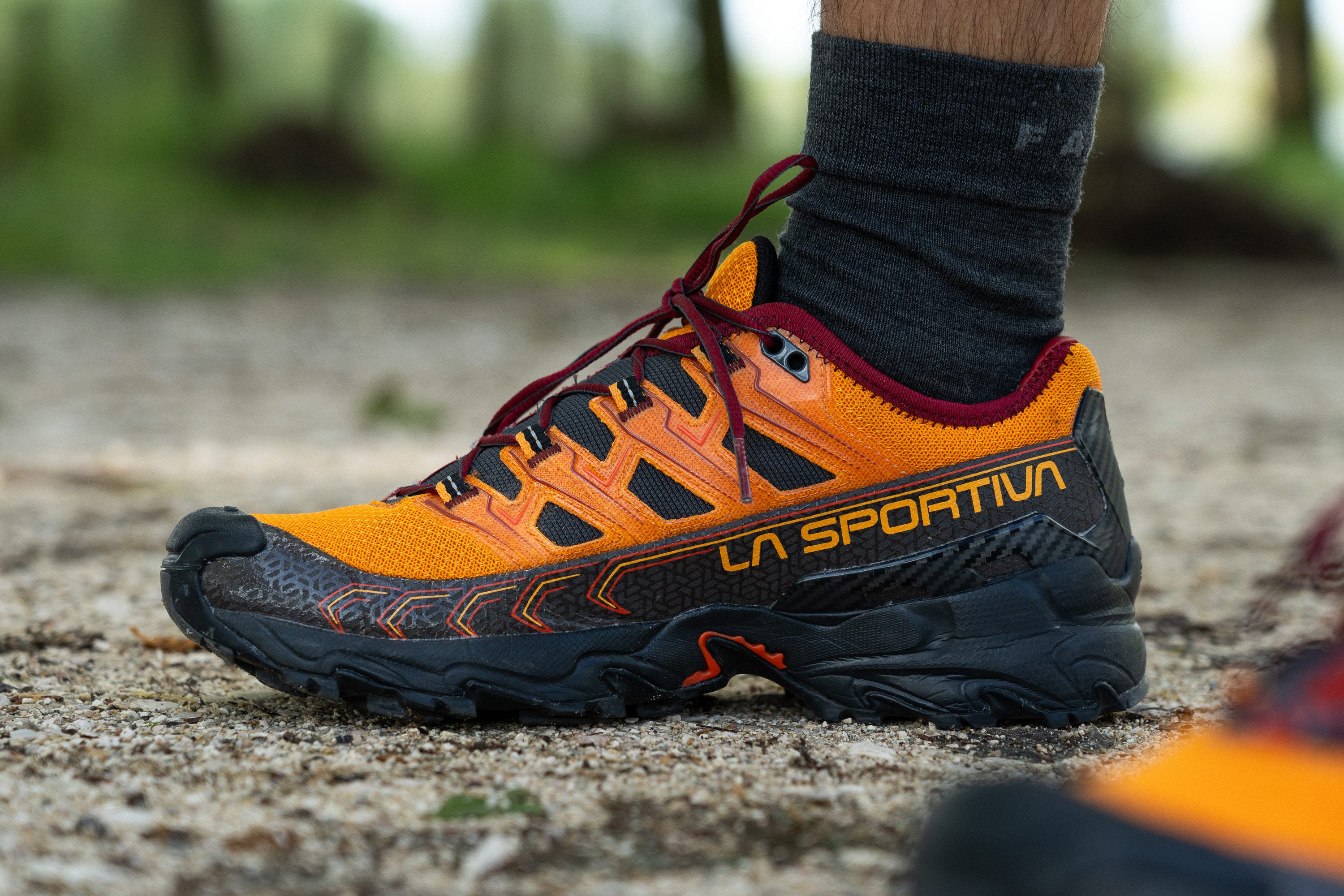
Rigidez torsional
Cuando las intentamos retorcer no cedieron prácticamente nada, así que se llevaron un alto 4/5 en nuestra prueba de rigidez.
Este es exactamente el tipo de sujeción que necesitas cuando te enfrentas a terrenos irregulares con una mochila pesada. No solo reduce la posibilidad de torceduras o esguinces de tobillo, sino que también reduce el cansancio de los pies en distancias largas.
La espuma firme de estas zapatillas, los clips de TPU en el talón y las resistentes superposiciones del upper trabajan codo con codo para mantener el pie estable en las La Sportiva Ultra Raptor II.
Mucho ojo, porque hay otro componente muy importante oculto en el interior de la mediasuela de estas zapatillas: un cambrillón rígido en el mediopié que ayuda a que la rigidez torsional sea incluso más alta, protegiendo al pie al pisar elementos duros.
| Ultra Raptor II | 4 |
| Media | 3.7 |
Rigidez del contrafuerte del talón
Después de haber analizado las Raptor II GTX, nos sorprendió que la versión que no es GTX de este modelo no fuese igual de rígida en el talón.
Aunque ambas zapatillas tienen exactamente las mismas estructuras de EVA y TPU, tienen cuellos diseñados de una manera un poco distinta, y las Raptor II estándar son las más flexibles.
Lo bueno es que nuestros talones y tobillos se sintieron bastante estables en las Raptor II estándar, pero sentimos la necesidad de utilizar ese doble ojal de la parte de arriba para conseguir un cierre más seguro.

| Ultra Raptor II | 3 |
| Media | 3.7 |
Anchura de la mediasuela - antepié
Para que unas zapatillas sean estables en terrenos técnicos, tienen que tener una base que sea bastante ancha, pero sin pasarse... ya que podría comprometer la precisión de la posición del pie.
La Sportiva lo tiene en cuenta haciendo que la mediasuela de las Ultra Raptor II sea lo suficientemente ancha. Nuestro calibre midió la parte más ancha del antepié y marcó 108,6 mm, un resultado que está un poco por debajo de la media.
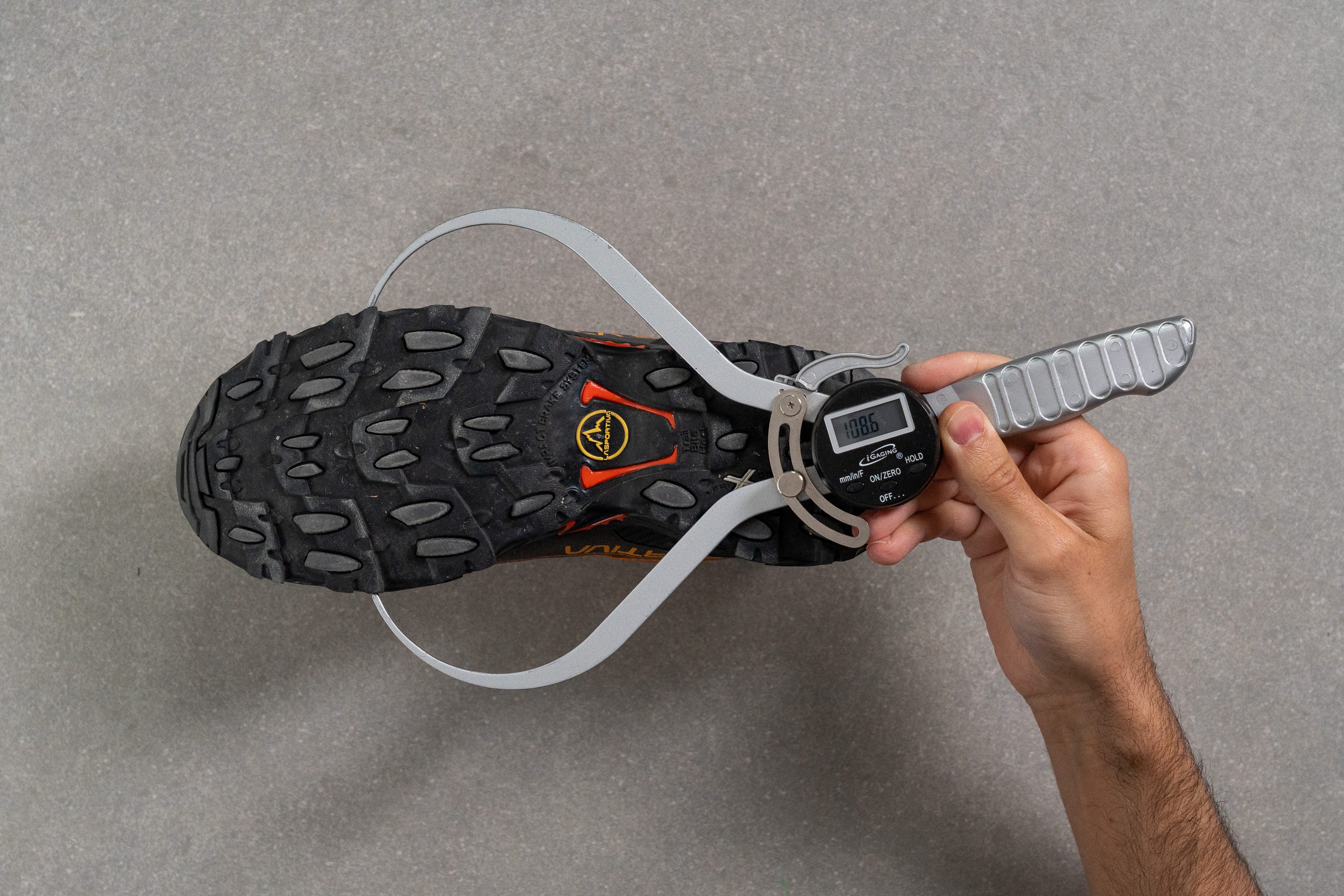
| Ultra Raptor II | 108.6 mm |
| Media | 111.3 mm |
Anchura de la mediasuela - talón
Del mismo modo, el talón de estas zapatillas tampoco es muy ancho. Cuando medimos su punto más ancho, nuestro calibre marcó un resultado más bajo que la media: 83,5 mm.
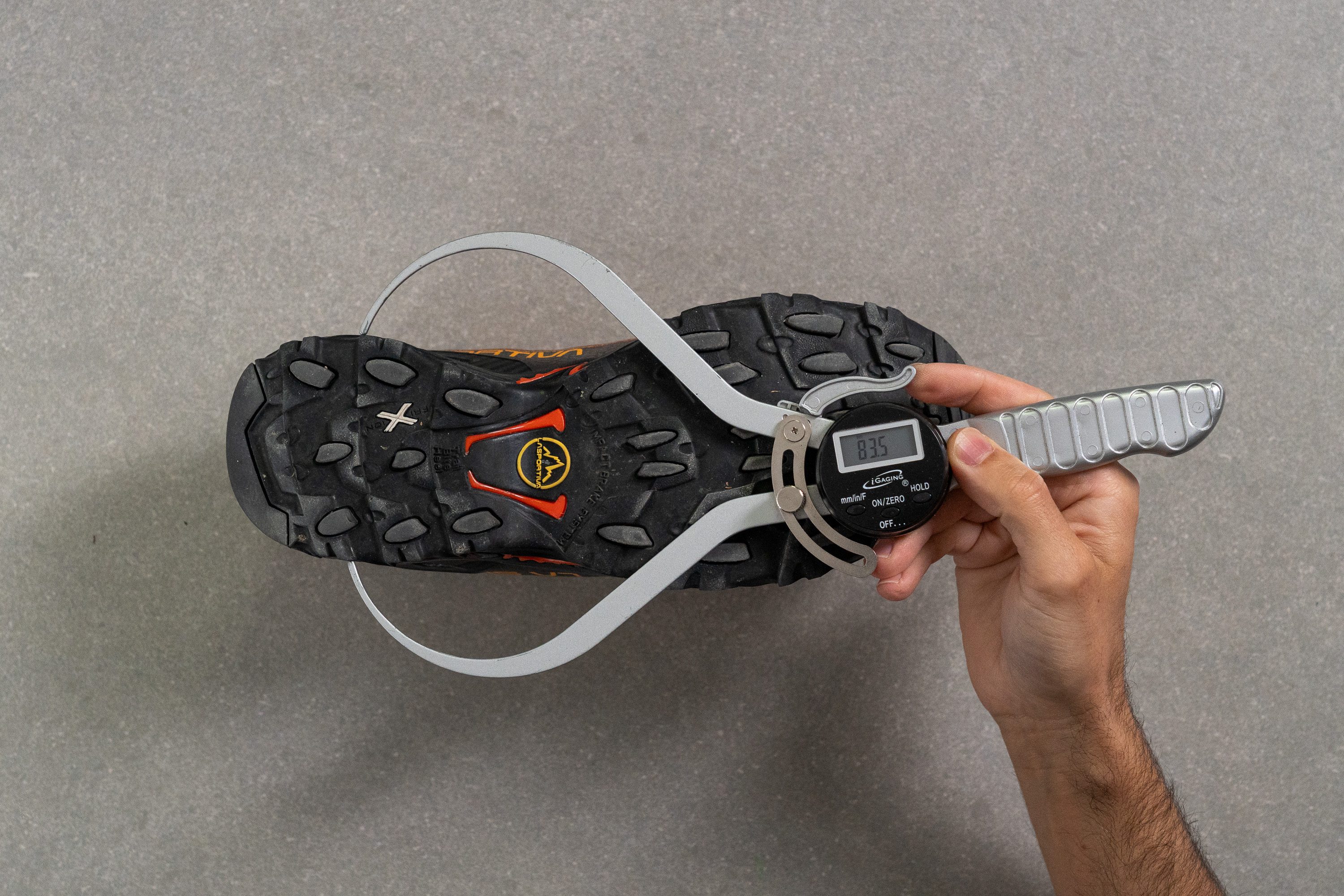
| Ultra Raptor II | 83.5 mm |
| Media | 87.9 mm |
Durabilidad
Durabilidad de la parte delantera
Eso sí, que las Ultra Raptor II sean más transpirables tiene un precio, así que no te puedes esperar la misma resistencia a la abrasión que tienen las Raptor GTX. Está claro que su resistencia ante arbustos afilados o los golpes contra las rocas es totalmente distinta:
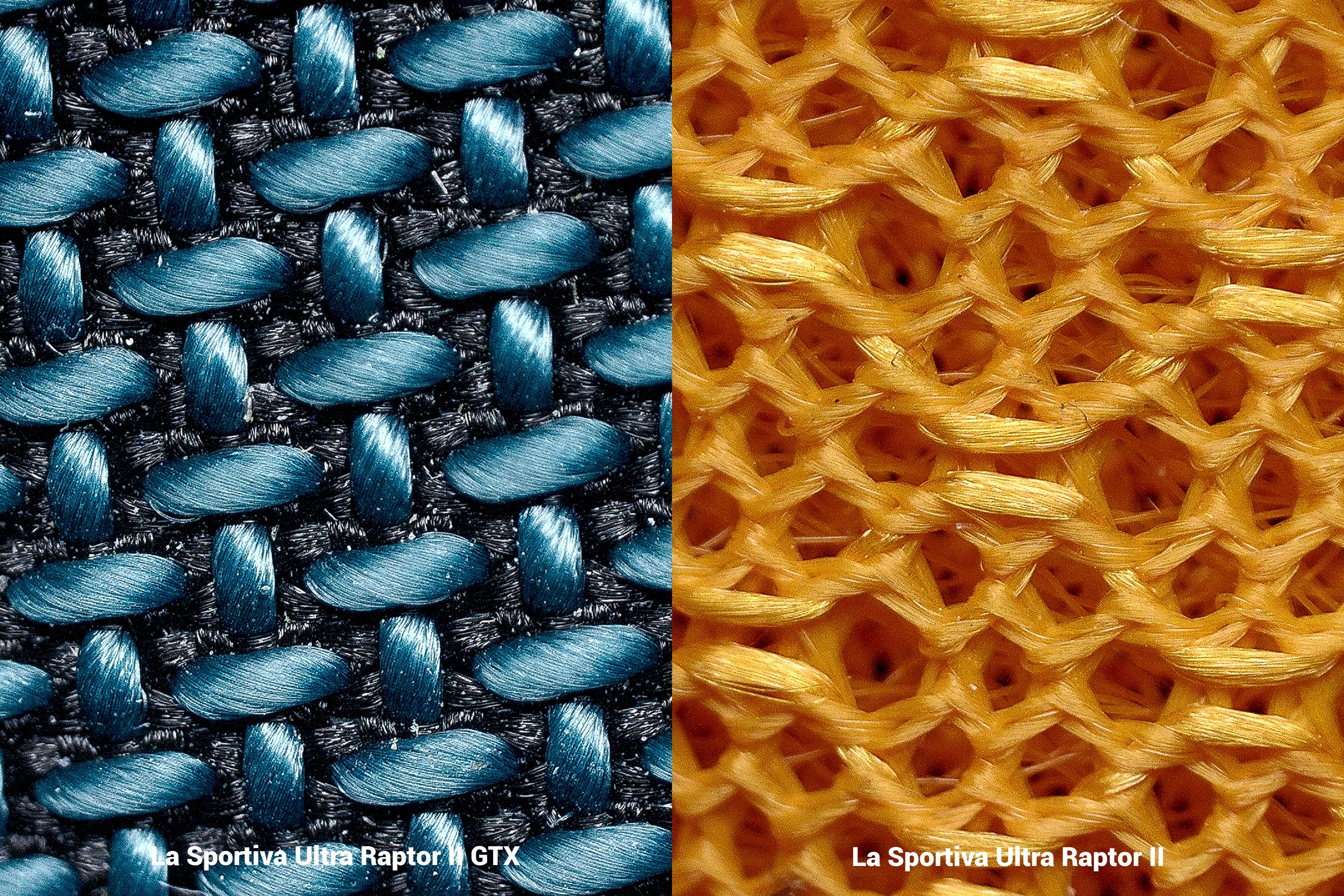
Ambos materiales se sometieron a la misma prueba Dremel y la versión sin GTX demostró ser bastante menos duradera. La herramienta la desgarró casi por completo, por lo que se llevó una puntuación baja: un 2/5.
Lo bueno es que las Ultra Raptor II se han reforzado con una banda de microfibra en los laterales del antepié, además de que tienen un refuerzo de goma en la punta que es igual de resistente que el de sus compañeras GTX. Vamos, que al menos las zonas más peligrosas y propensas al desgaste están protegidas.
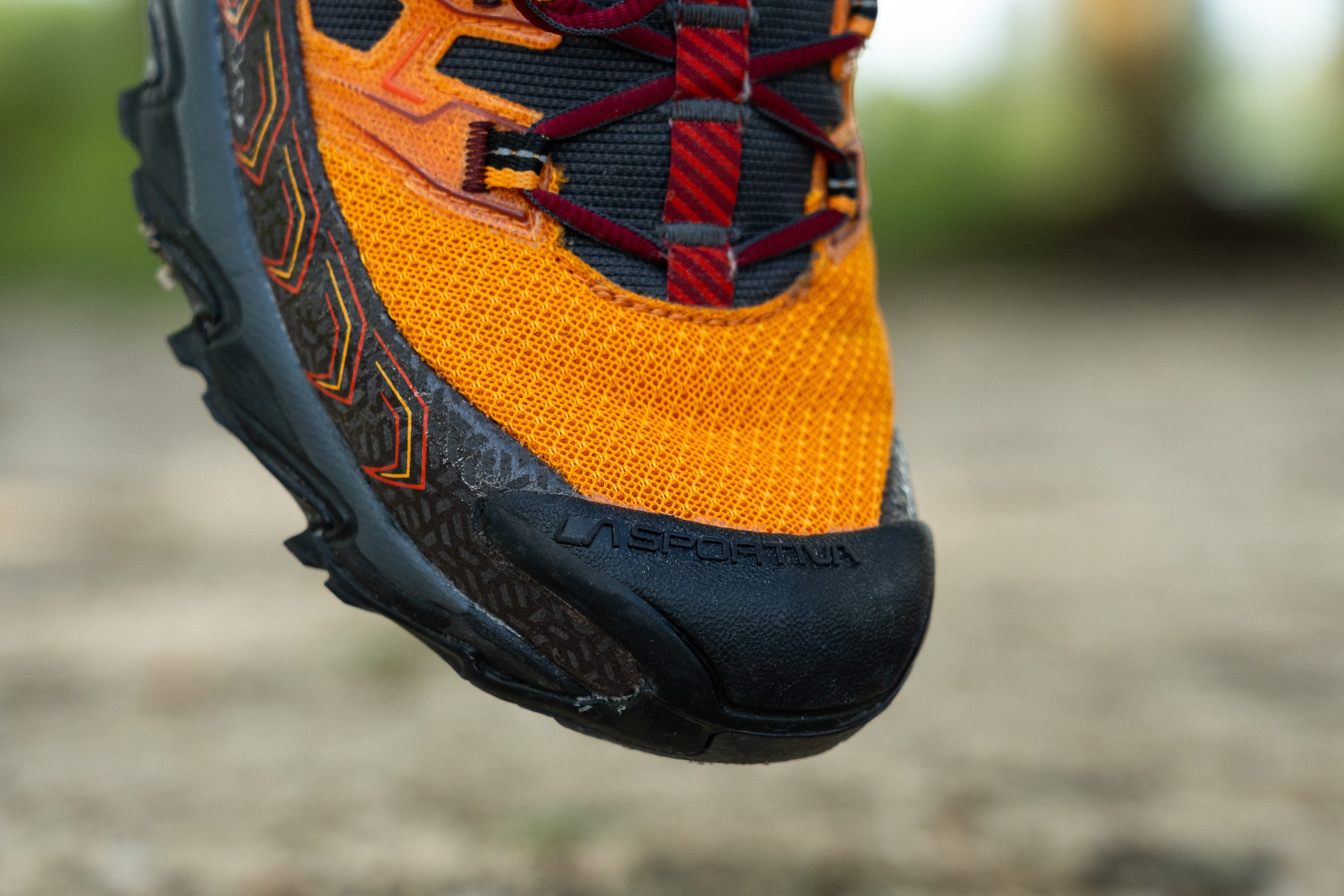
| Ultra Raptor II | 2 |
| Media | 3.7 |
Durabilidad del acolchado del talón
Aunque no es algo que veamos a menudo en las zapatillas de senderismo, La Sportiva eligió el cuero para el forro interior del cuello de las Ultra Raptor II. La resistencia al desgaste de este material es excelente, llevándose un 4/5 en nuestra prueba Dremel, así que no tenemos queja.
Eso sí, nuestra recomendación es que utilices calcetines altos para que no te rocen en el tendón de Aquiles o en otras zonas de por ahí, sobre todo durante el periodo de adaptación.
| Ultra Raptor II | 4 |
| Media | 3 |
Dureza de la suela
Las Ultra Raptor II tienen la suela exterior de caucho FriXion White, que es propiedad de la marca, y esto tiene tanto sus ventajas como sus desventajas.
¿La ventaja? Que ofrece un agarre expectatular.
¿Y la desventaja? Pues que no es la suela exterior más duradera. Aunque obtuvo un resultado sólido cuando la analizamos con nuestro durómetro, de 84,0 HC, nuestro Dremel nos dejó claro que no está echa para para durar.

| Ultra Raptor II | 84.0 HC |
| Media | 85.1 HC |
Durabilidad de la suela
Cuando taladramos uno de los tacos de estas zapatillas a una velocidad de 10K RPM durante 18 segundos, nos decepcionó la rapidez con la que la herramienta lo hacía añicos.
A ver, sí que podríamos decir que unos daños de 1,2 mm no son tan profundos en comparación con la media de la categoría pero, teniendo en cuenta lo que cuestan estas zapatillas de La Sportiva, la verdad es que es bastante decepcionante. Hay modelos de senderismo mucho más baratos con daños de solo 0,3 mm después de esta misma prueba (como las Salomon Outpulse).
| Ultra Raptor II | 1.2 mm |
| Media | 1.0 mm |
Grosor de la suela
Nos gustó que el grosor de la suela exterior de estas zapatillas estuviese a la par con la media con sus 2,4 mm, pero dada su falta de durabilidad, puede que empieces a perder los tacos (y el agarre) antes de lo que esperabas.
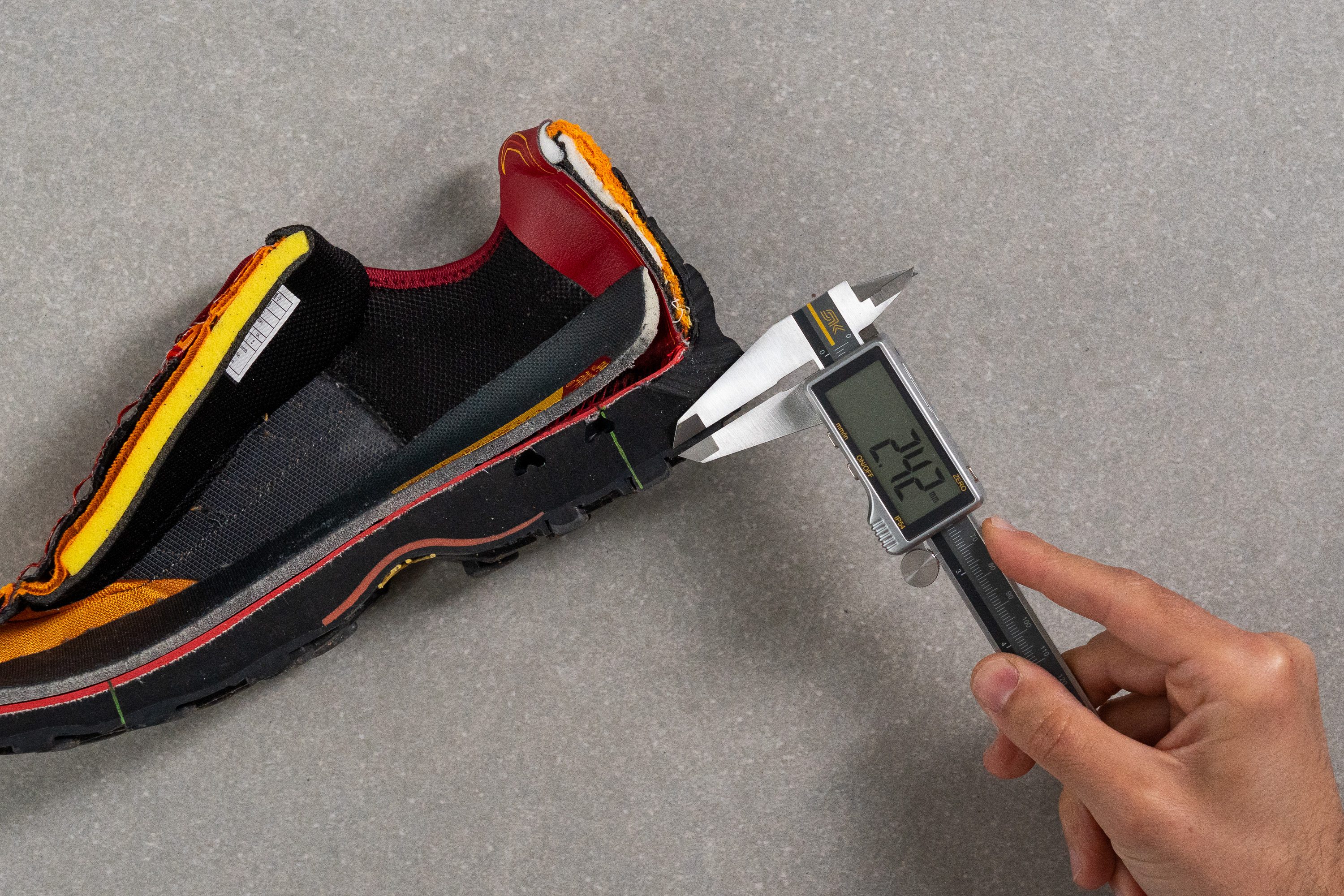
| Ultra Raptor II | 2.4 mm |
| Media | 2.5 mm |
Varios
Grosor de la plantilla
La plantilla OrthoLite de este modelo tiene un grosor decente de 3,5 mm, pero no está tan acolchada como otras plantillas que hemos visto en otras zapatillas de senderismo.
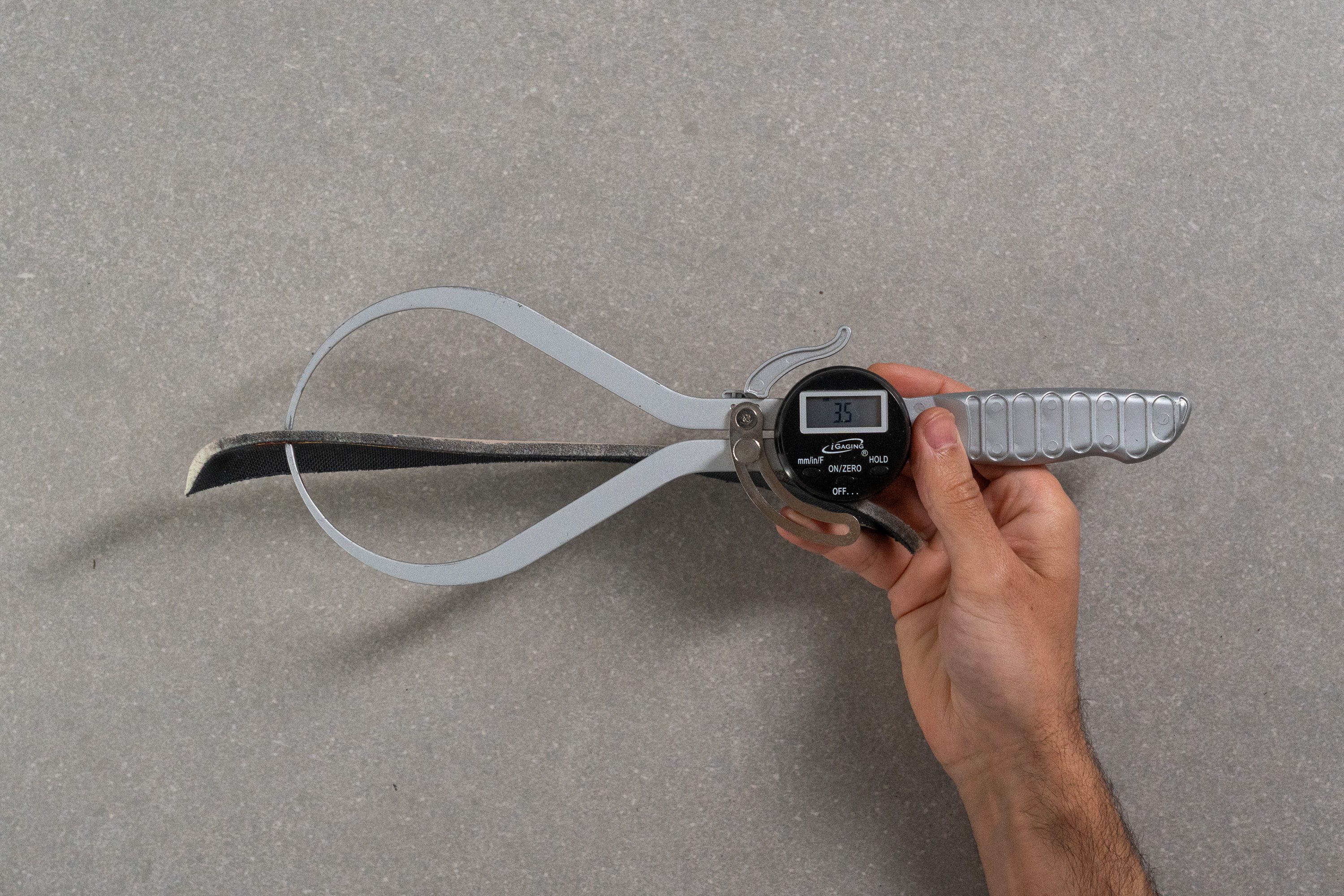
| Ultra Raptor II | 3.5 mm |
| Media | 5.3 mm |
Plantilla extraíble
La plantilla OrthoLite que tienen se la puedes quitar sin problema, así que no te preocupes si quieres utilizar otra por lo que sea.
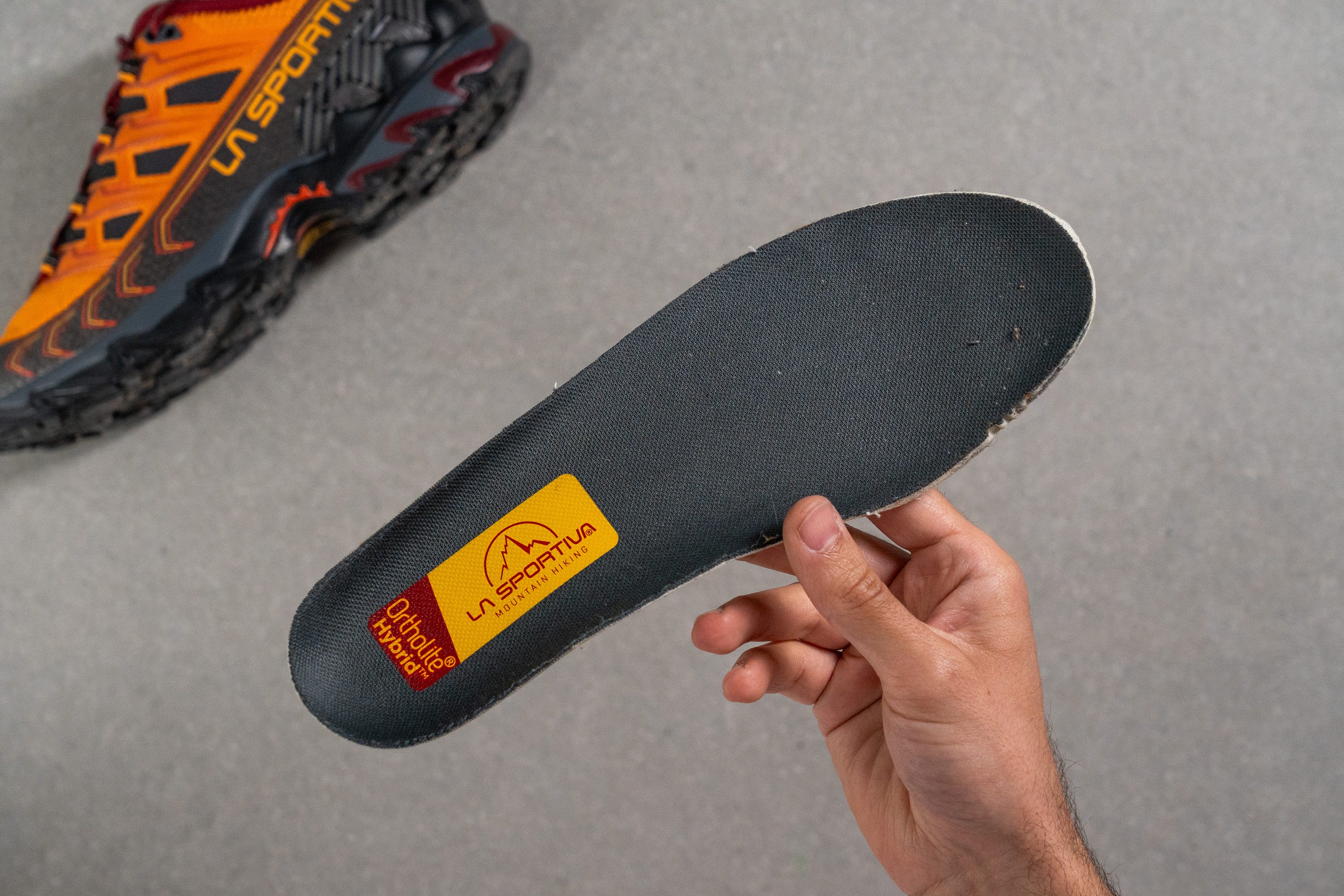
| Ultra Raptor II | Sí |
Rigidez de la mediasuela en frío (%)
Lo bueno de las zapatillas rígidas es que no se vuelven mucho más rígidas cuando hace frío.
Después de meter las Ultra Raptor II en el congelador durante 20 minutos, volvimos a coger nuestro durómetro para ver cómo reaccionaba la espuma EVA a las bajas temperaturas. Con un aumento moderado del 17 %, no se volvió más rígida que la media de las zapatillas de senderismo.
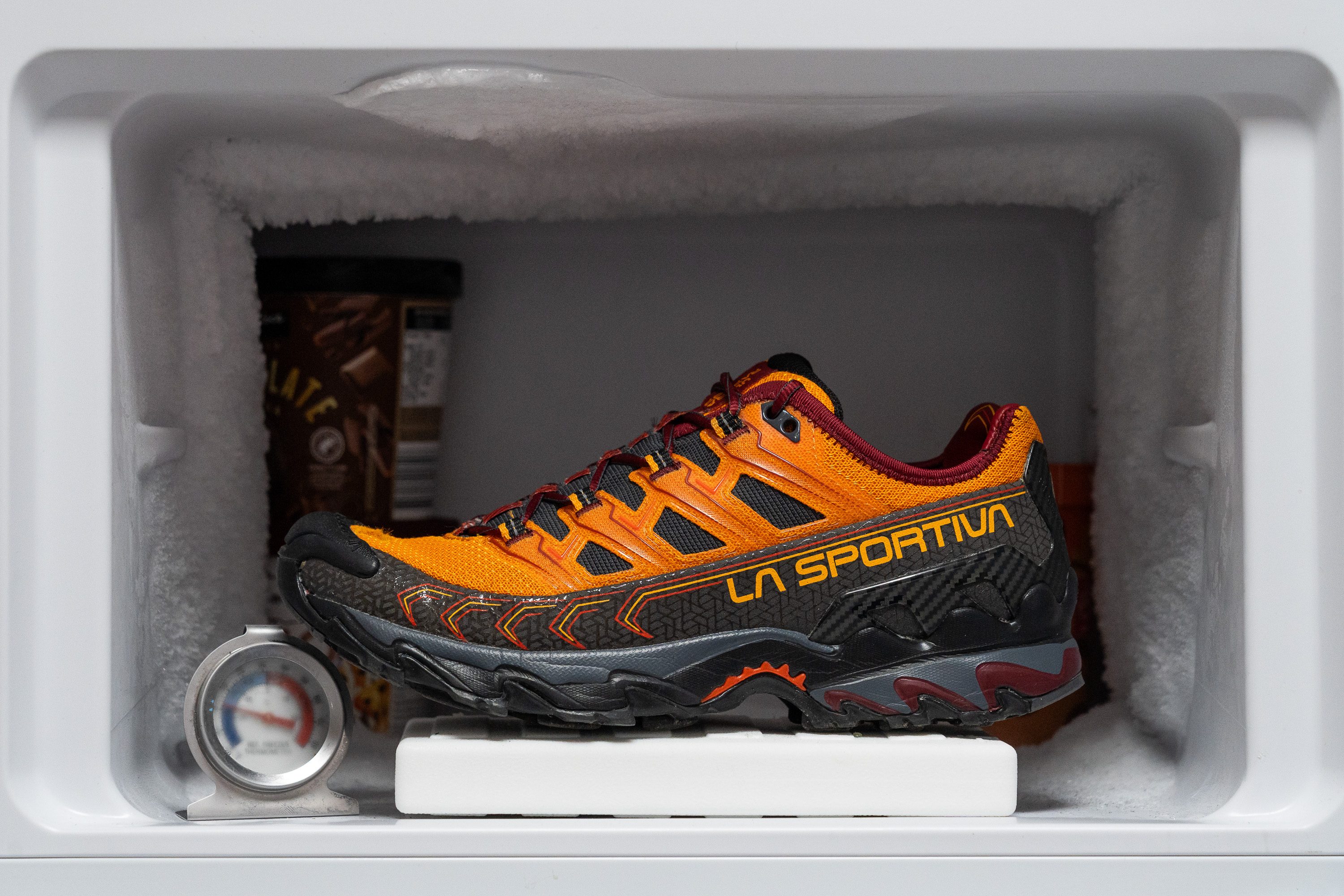
| Ultra Raptor II | 17% |
| Media | 19% |
Elementos reflectantes
Ninguno de los componentes de este modelo es reflectante.
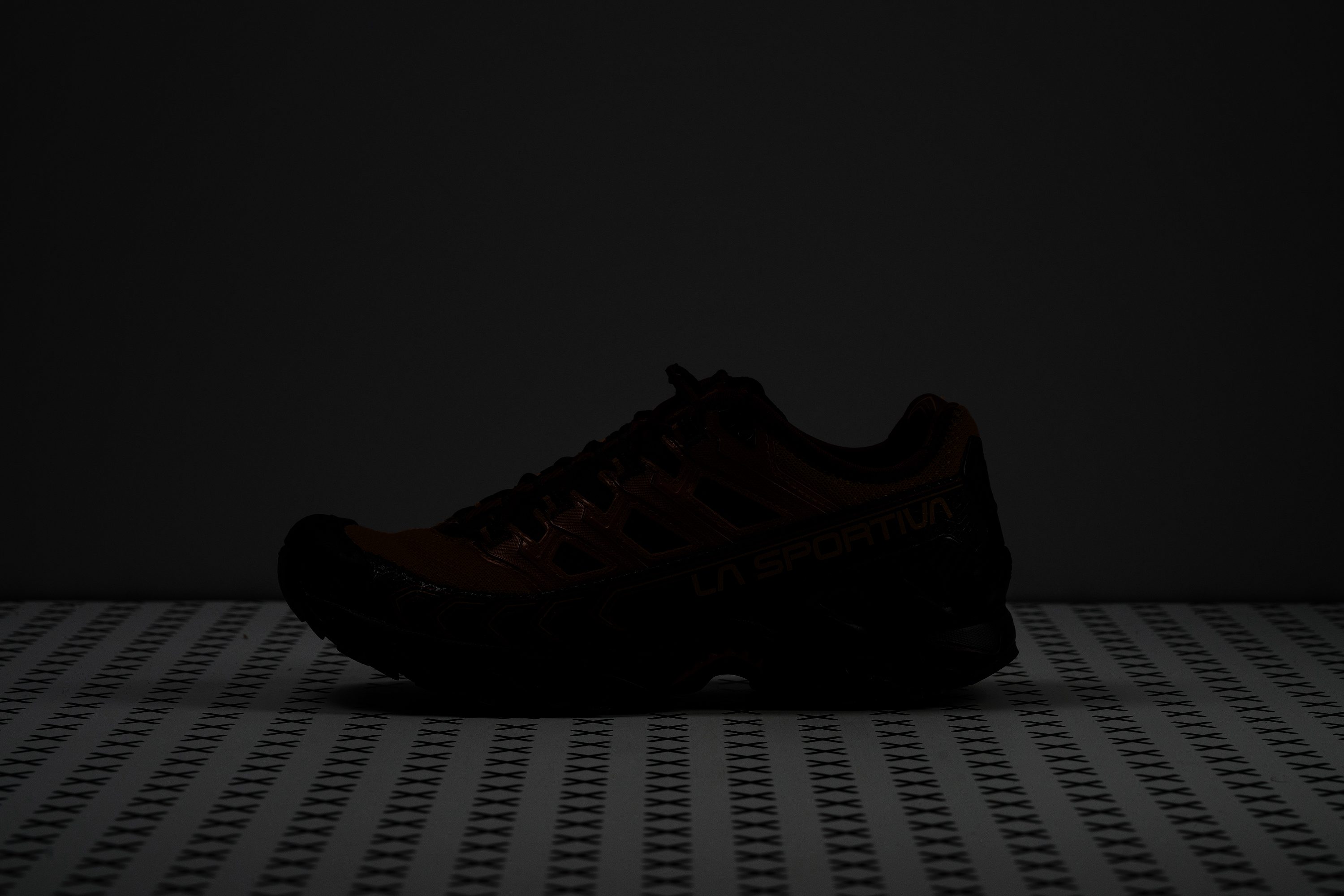
| Ultra Raptor II | No |
Acolchado de la lengüeta
Parece que la mayor parte del acolchado interior de estas zapatillas está en la lengüeta. Cuando las cortamos por la mitad, vimos que el acolchado de la lengüeta es igual de grueso en la parte de abajo que en la de arriba, y cuando lo medimos nuestro calibre marcó 12,2 mm.
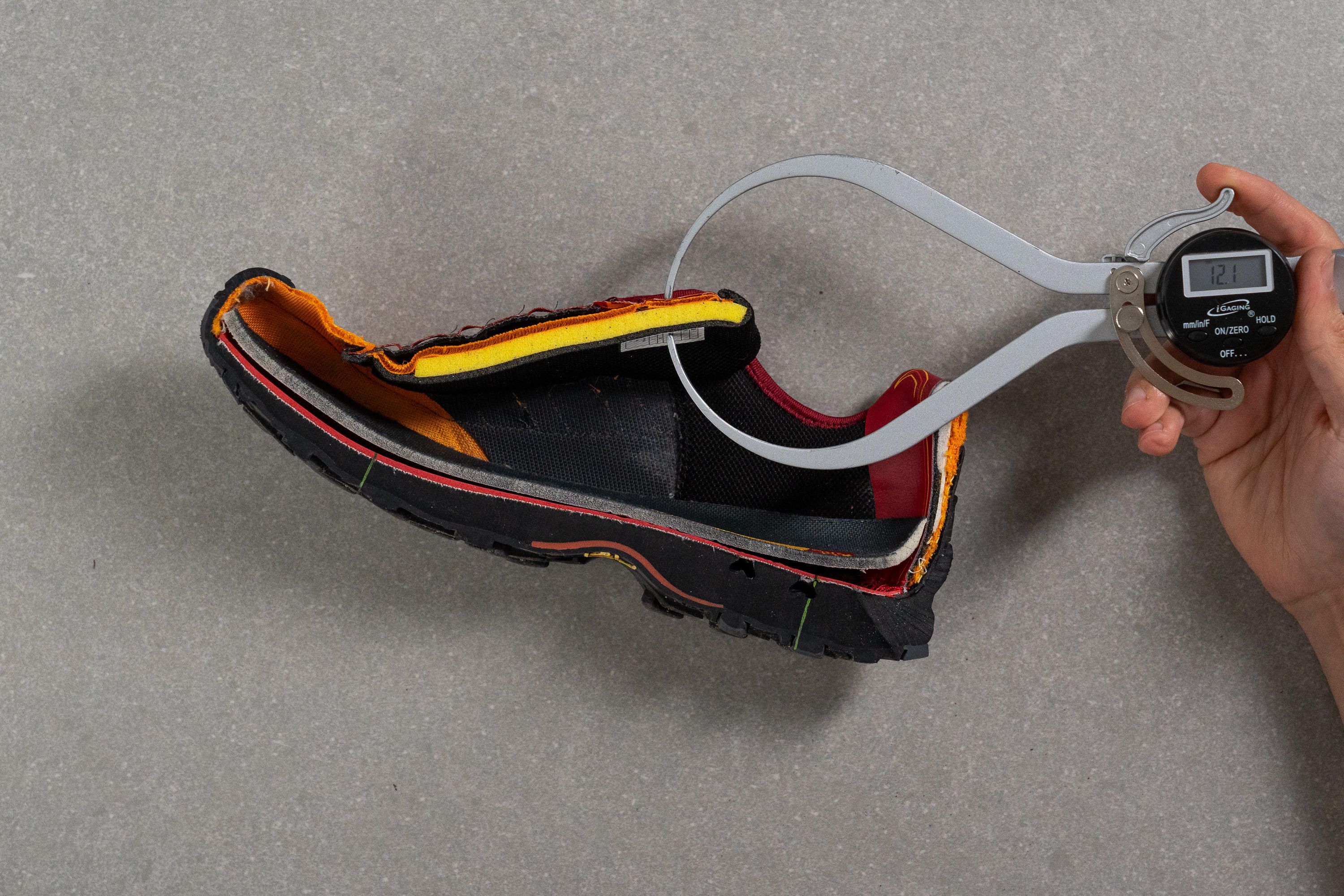
| Ultra Raptor II | 12.1 mm |
| Media | 10.2 mm |
Lengüeta: tipo de refuerzo
Aunque no son unas zapatillas impermeables, las Ultra Raptor II tienen un diseño tipo botín parecido al de su versión GTX. La lengüeta no está separada del resto del upper y no hay huecos por los que se puedan colar las piedrecillas o la tierra fácilmente.
A ver, sí, este diseño hace que cueste un poquito más ponerse y quitarse las zapatillas, pero también hizo que nuestros pies se sientiesen muy seguros cuando nos calzamos.

| Ultra Raptor II | Botín |
Precio
En nuestra opinión, el precio de estas zapatillas de La Sportiva es demasiado alto, sobre todo teniendo en cuenta que no son GTX.
Es uno de los modelos de senderismo más caros de nuestro laboratorio, pero no estamos seguros de que esté a la altura cuando el listón está tan alto. A ver, sin ninguna duda son unas zapatillas alpinas que tienen un buen rendimiento, pero la falta de durabilidad de su suela no se corresponde con su precio.
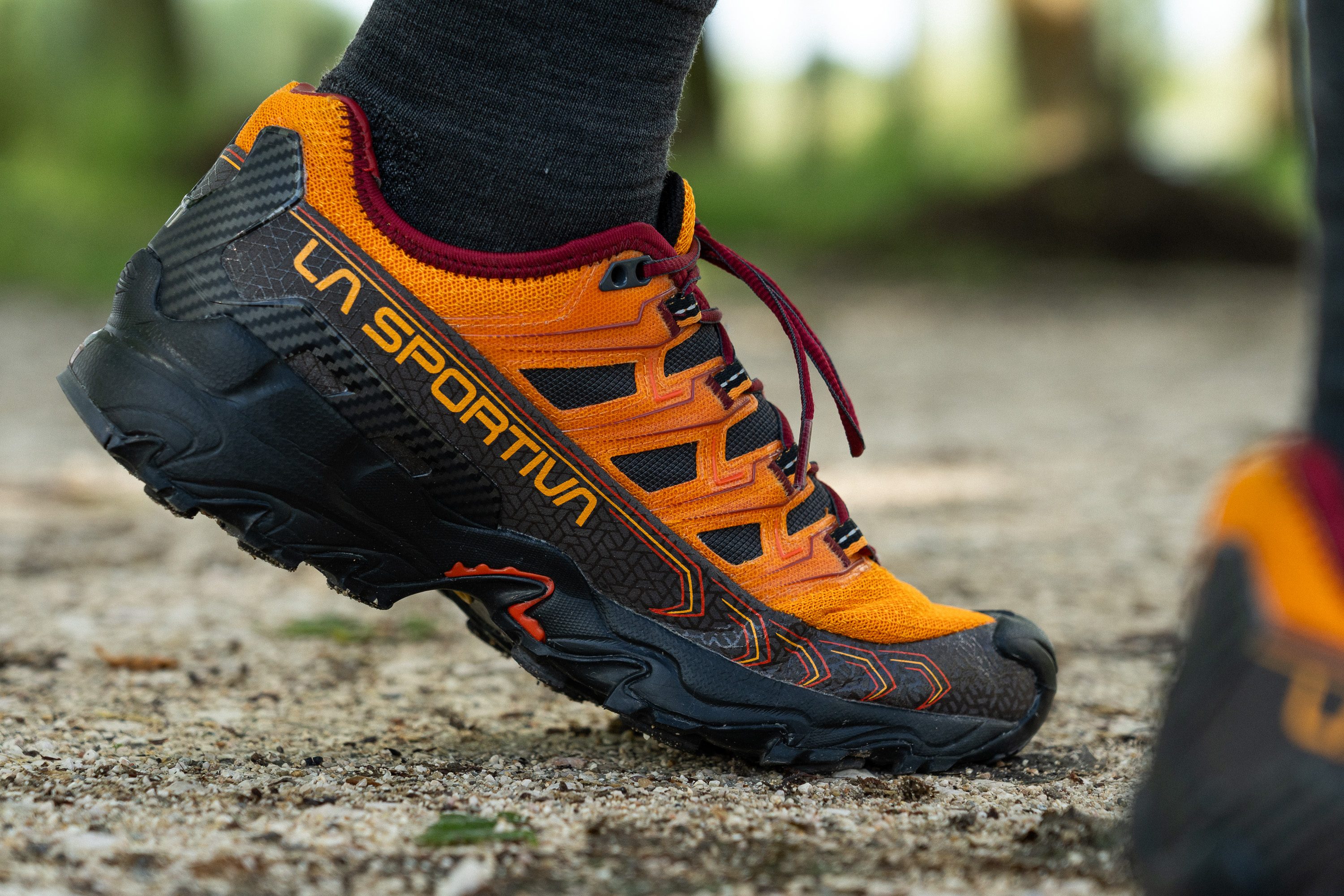
| Ultra Raptor II | $205 |
Tirador del talón
Es una pena, pero tampoco tienen un tirador para que calzarse sea más fácil.
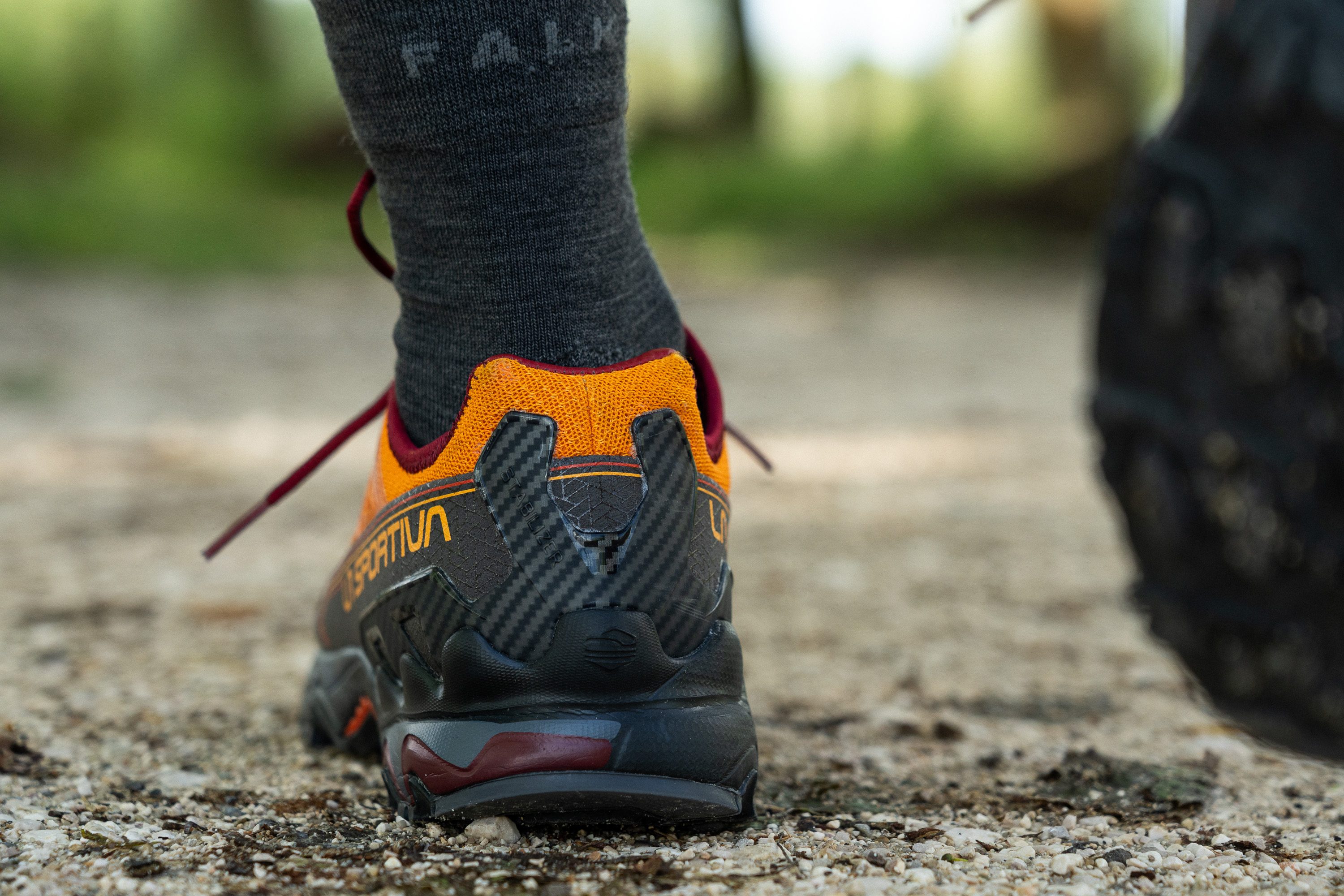
| Ultra Raptor II | Ninguno |

